Vintage News 2019
Gleaming advert at Pickering station – Dec 2019
There’s a new look to Pickering station – and, furthermore, it is in full keeping with the LNER 1935 image that this terminal station portrays.
The two non-passengers vehicles which have received so much attention in the past months – Covered Carriage Truck No. 1308 and Gresley Restaurant First No. 42969 are now ensconced in the Beck Siding at the north end of the station adjacent to platform 1. This siding was formerly connected to the main line but when the point became due for renewal, the cost could not be justified, so plain line was installed, thus isolating the siding. Spare wheels have previously occupied this space but now, on full view to passengers and passers by on the road, and also the opposite residents on Park Street are:
The CCT just needs the north end doors completing – this work is underway in the LNERCA’s High Mill workshop and once fitted will see 1308 finished. It looks magnificent and even carries the correct warning ‘Not to work on Mersey Dock estate’.
The Gresley carriage earns its keep as the Upholstery store and doesn’t it look the bee’s knees, for it carries LNER Departmental Oxford blue. This is a ‘first’ for this country in the preservation sector.
Both the CCT and Gresley were ‘manhandled’ into the former siding by MPD and C&W staff. One of these was Charlie Dore who, when based at Stratford depot, east London, used to ride in this carriage when it was Departmental stock (Staff & Tool Van No. ADE 320947) after it ceased being used for passenger use in 1963).
Buffet Car back in business
Gresley Restaurant Buffet No. 641, the worst of those vandalised in 2017, is finally up and running after its major repair and completion of due maintenance. Most of this work was accomplished off site by Lee Sharpe and his wife Mandy at Wirksworth on the Ecclesbourne Valley Railway, north of Derby.
On arrival by road from Wirksworth on August 7, 641 went into the C&W paintshop to be varnished and have its lettering applied – some of these were transfers, the rest hand painted by Peter Whitacker.
641 was ‘outshopped’ in mid early December and used for the Festive Tea service.
The LNERCA is planning a relaunch at the start of the next running season to mark its return to the LNER set. We have two ‘celebrities’ in mind up to cut the ribbon!
A fishy tail (or is it tale?)
Somewhat incredibly, after decades ‘lost’, an identical body of a LNER Fish Van to that owned and under restoration to a complete vehicle by the LNERCA, has come to light on a remote farm only 30 minutes from Pickering. Considering that only five bodies of this type survive (built by Faverdale Works, Darlington, in 1948/9 to Diagram 214), two in Scotland and three, remarkably, in South Wales, to find one on the doorstep was an eye opener. The owner has willingly helped the LNER to photograph it and has offered any parts required. His fish van body does have at least two items that ours, 75169, does not.
The owner tells us the body came from Goldthorpe in South Yorkshire in the mid 1970s.
There is no surviving worksplate and the painted number has long been obliterated, so we have no knowledge of its original identity.
What’s in store?
Looking ahead to 2020, the year will see Gresley BTO No. 43567 finished (it is in the Atkins shed receiving copies quantities of vanish) and go back in the LNER set, as will Gresley Buffet 641. Attention will turn to repairing TTO No. 23956.
After a disappointing, protracted delay, work should start in earnest on rebuilding the Fish Van E 75169.
Meanwhile at RSR North East’s Spennymoor premises, work on the Thompson CL No. 88339 is progressing – the doors are off for repair by our joiner Jim Chittock and one side paneling has been removed to ascertain what needs undertaking in frame repairs. Also at Spennymoor, NER TO No. 945 should be receiving its new roof covering, the type of which has yet to be decided.
Have a good one
Finally, seasonal best wishes to all readers and many thanks for your support. We hope you continue to enjoy reading what goes on in the world of LNER vehicles!
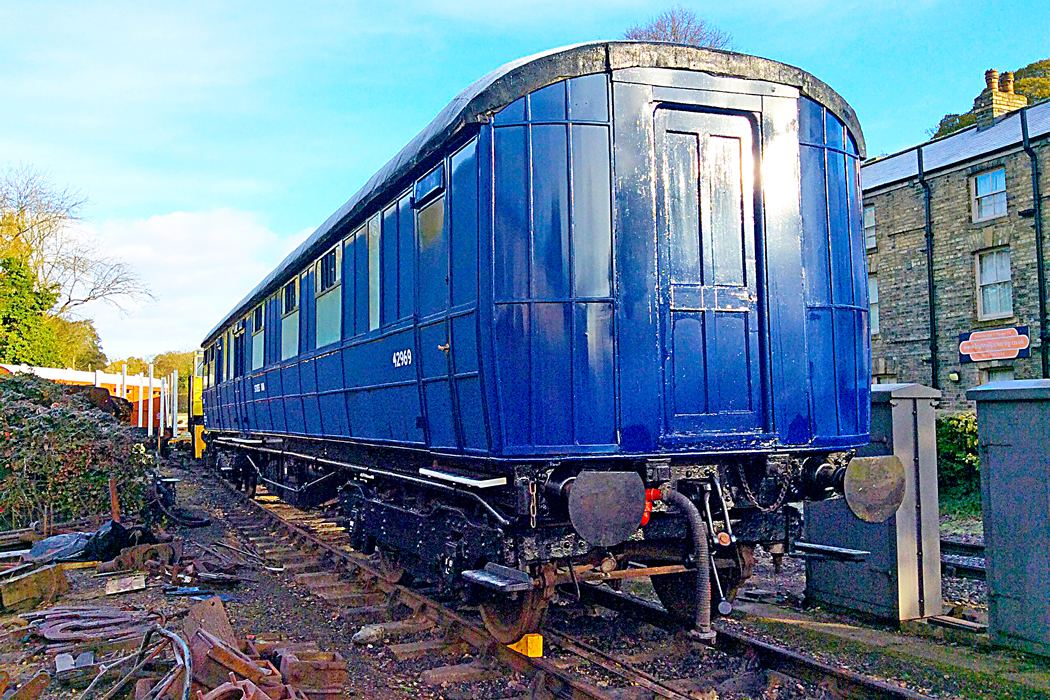
Wow! Never before seen in this country in the preservation era, a Departmental Gresley carriage in correct Oxford blue. Whilst many Gresleys survived in the BR era by being converted to Departmental use (i.e. they ceased to be passenger carrying, and were allocated to the Civil Engineer or Mechanical & Electrical Engineers’ Departments) they carried firstly red, then olive green, and latterly yellow. 42969 carries the correct colour in keeping with the era in which Pickering station is restored. (Photo: Dave Cullingworth)
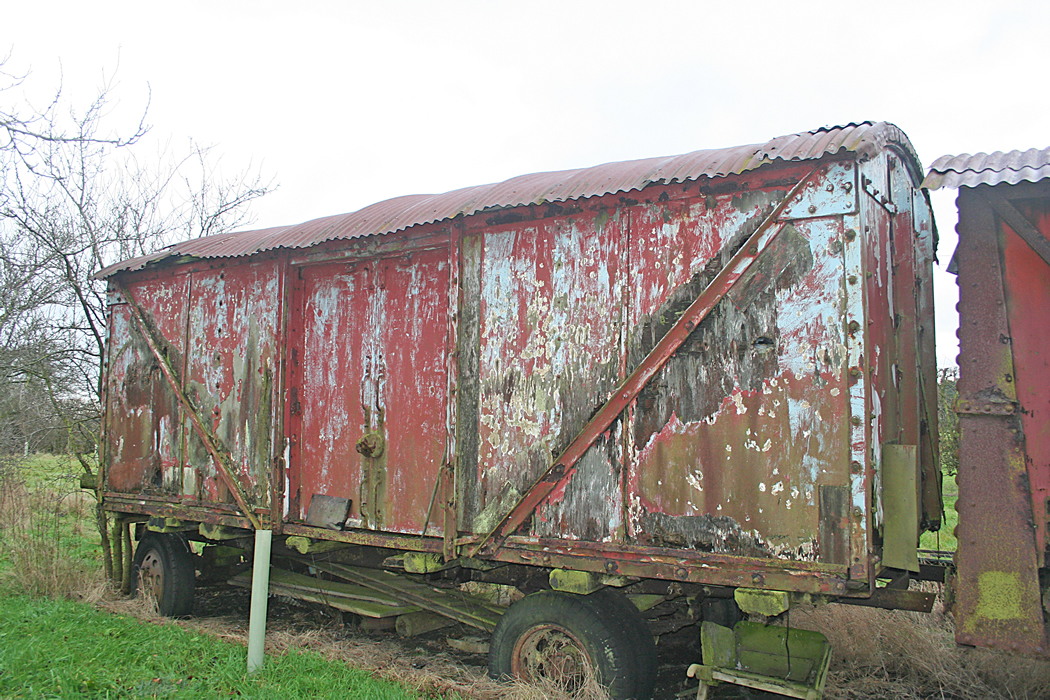
A real find! Just a derelict van body on a farm – an everyday sight on farms across Britain – but this is the identical type to the LNERCA’s Diagram 214 Fish Van built at Faverdale Works, Darlington – and the van body is only 13 miles from Pickering. Thanks to the support of the owner, we will be recovering whatever parts we need when our own 75169 is put back together. Photo: Murray Brown.
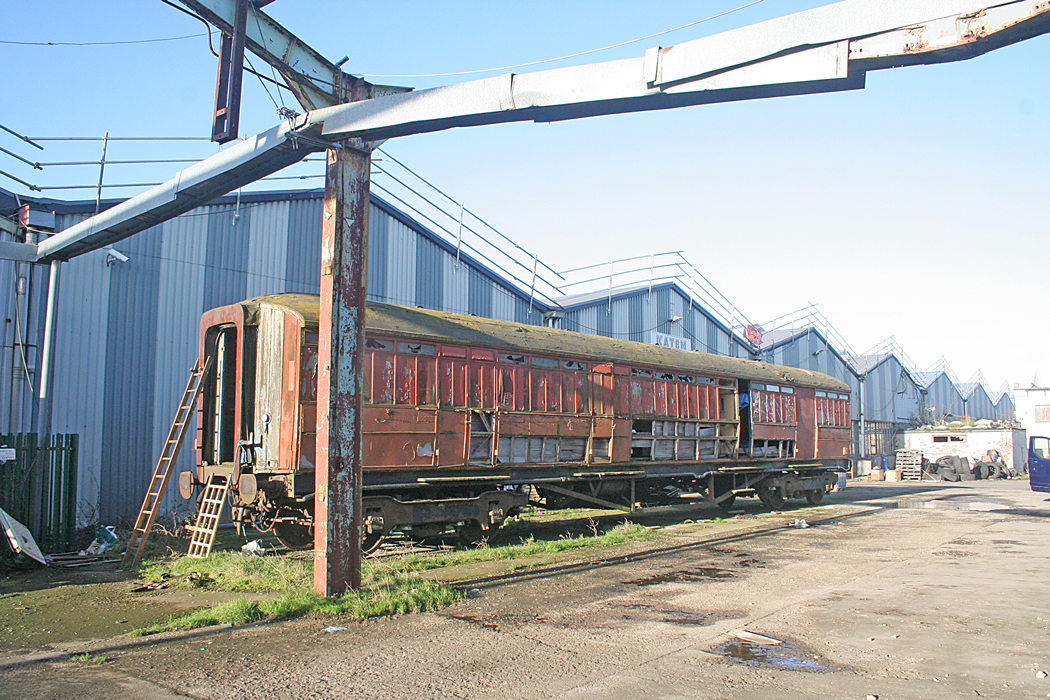
There will soon be another LNER Gresley carriage coming to the NYMR but, to quote Captain Spock, not as we know it, Jim. The carriage is owned by the NYMR. This is Gangwayed Passenger Brake Pigeon van (BGP) No. 70754 and is in somewhat derelict condition, currently parked at Spennymoor, County Durham. This 77-year old Gresley passed into the preservation sector in 1991 having been used as an Internal User vehicle at Heaton depot. (No. 041366). The North Tyneside Railway (Stephenson Railway Museum) took over ownership and undertook some remedial attention. However, it deteriorated, not helped by vandal attack. This carriage is destined to become the Educational facility at Goathland as part of the ‘Yorkshire’s Magnificent Journey’ project. It is to receive steel panels and be painted, it is understood, in NER crimson. It is one of only seven surviving complete examples of this type. However, it is not being altered structurally and any internal fittings removed for its future role will be retained for safe keeping. Photo: Murray Brown.
LNERCA notches up 40 years – Sept 2019
This year is the 40th anniversary of the founding of the LNER Coach Association. Four decades ago, there were two factors in the thinking of the forming of the LNERCA whose aim was to procure and restore a set of LNER carriages for use on the NYMR.
1979 was the year the government made the decision to abandon the concept of keeping mobile control trains for use in wartime whereby they could be stabled in isolated branches or sidings and control the railways in case the railway headquarters were put out of use. Significantly, the Scottish, former North Eastern and Eastern (the latter two regions of which were merged in 1967) all had four-coach Gresley carriages converted for this specialised use. Each region had two train sets. Thus the official condemnation of these mobile control trains meant that 24 Gresley carriages came on the market. What an opportunity – except many of them had been extensively structurally altered for their secret role.
Secondly, one of the founders was in charge of disposal of condemned rolling stock on the Eastern Region and at the time there was a procession of Departmental LNER carriages making their way to scrapyards – heartbreaking for anyone interested in pre-BR coaching stock.
So, the idea was born to form an association with the laudable, but questionable aim of putting together a set of LNER carriages. Questionable? Yes, because of the sheer cost. There would be two avenues to explore: Firstly, could any member be tempted to buy a carriage outright and, secondly, could an appeal raise enough money to buy and transport a carriage to the LNER, assuming the NYMR would entertain the idea?
With a ‘fiver’, an account was opened at the Leeds Building Society in Coney Street York. Interested individuals were soon joining. The rest is history. We have run a 7-coach LNER train on the NYMR. The LNER set is not owned by the LNERCA, but comprises four different owners of rolling stock. The LNERCA is the umbrella organisation. What is frightening is the time taken to restore a carriage from dereliction – often up to ten years with a prevailing wind. We also have eight more in the queue . . . . At least they have been saved from the scrapman, even if a future generation will be restoring them. Other vehicles have also come under our wing – we have affiliated carriages from other owners, and we possess a Covered Carriage Truck (CCT) and unique Fish Van.
To mark 40 years in the business, the annual members’ special train on October 5 will carry the appropriate headboard ‘The Quadragenarian – LNERCA At 40’
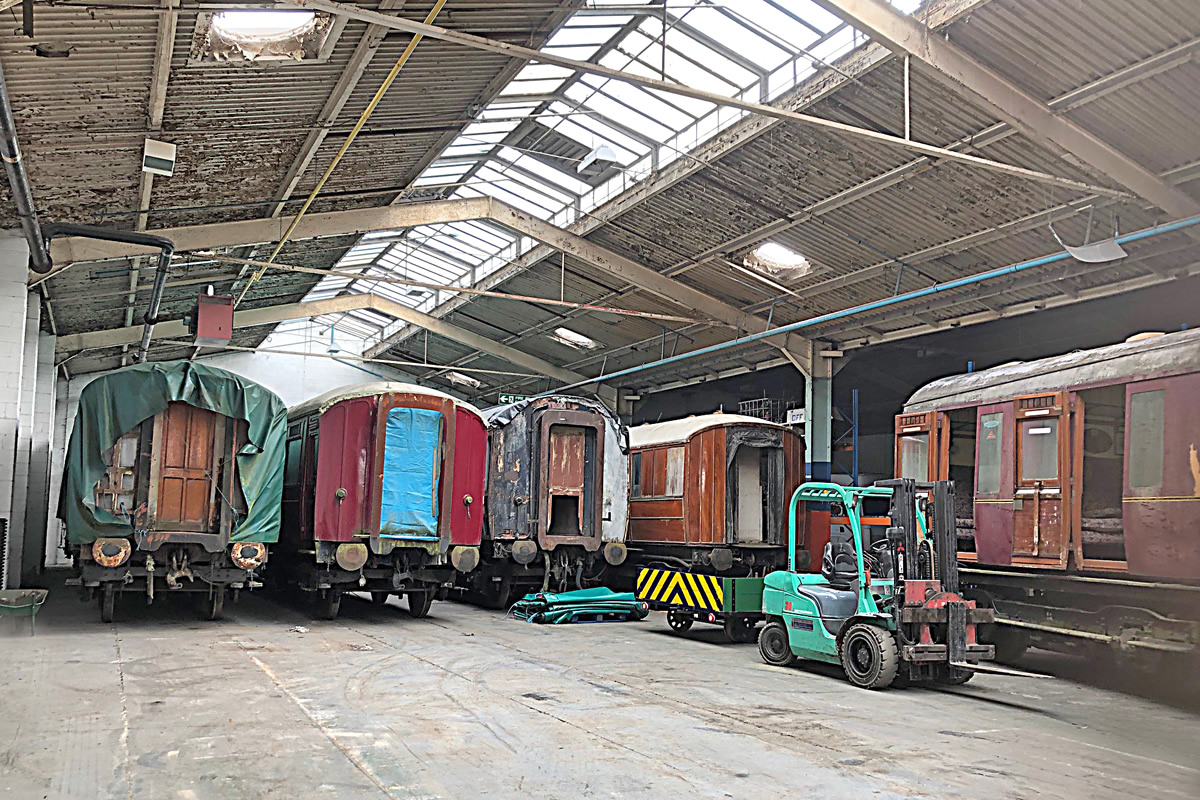
What luxury – this is what it is all about – carriages under cover. The storage facility at Spennymoor, Country Durham houses, from left to right, Gresley TK 23896, Bain (NER) Third Open 945, Thompson CK 18477, Gresley TTO 24109 and Thompson CL 88339. Of these only 23896 has been under cover before, the rest have been in the open for over 60 years. These carriages will return to the NYMR on completion of the carriage ‘stable’, one of the key components of the ‘Yorkshire’s Magnificent Journey’ lottery-supported project. Dereck Winters
Brake Third Open 43567: This 1935-built Gresley which last carried passengers on BR in 1960 but has since worked extensively on the NYMR once restored, has received thousands of man-hours preparing it for varnishing. Most regrettably, its external condition necessitated stripping it to bare teak and starting again. The work has entailed enormous amounts of sanding to eradicate stains and ingress of dirt and old varnish. It resides in the luxury of the Atkins shed where it is now being transformed back to its former glory.
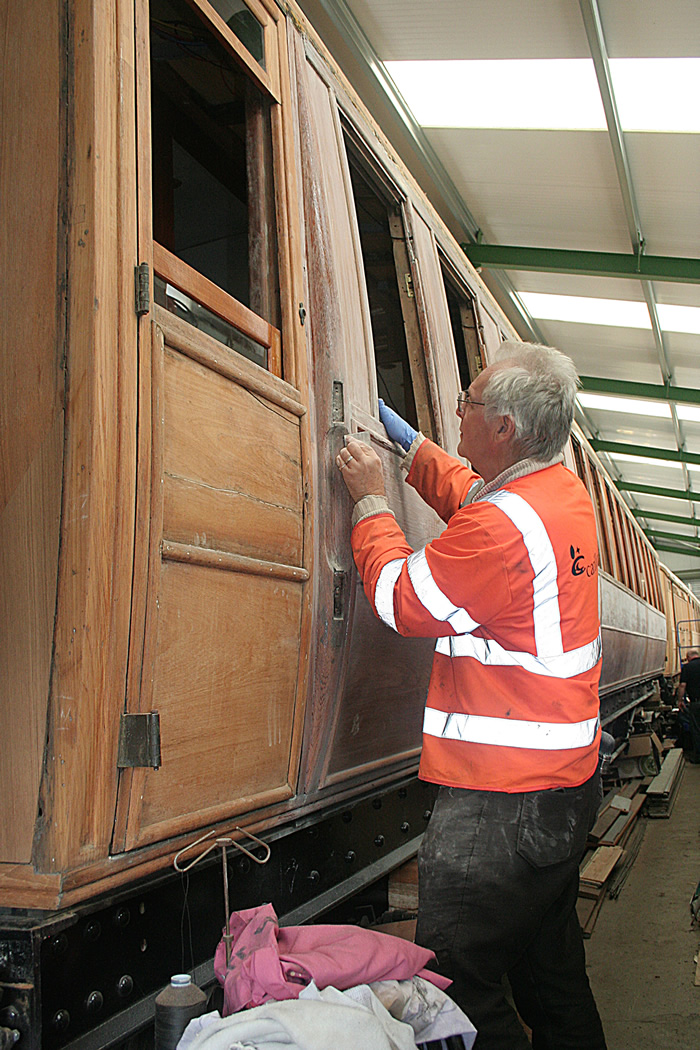
A staggering amount of time has had to be expended rubbing down the body of ECJS Restaurant Third 189 to eradicate scratch marks, old varnish and stains. Neil Cawthorne continues to make the surface acceptable prior to more coats of varnish being applied. Murray Brown
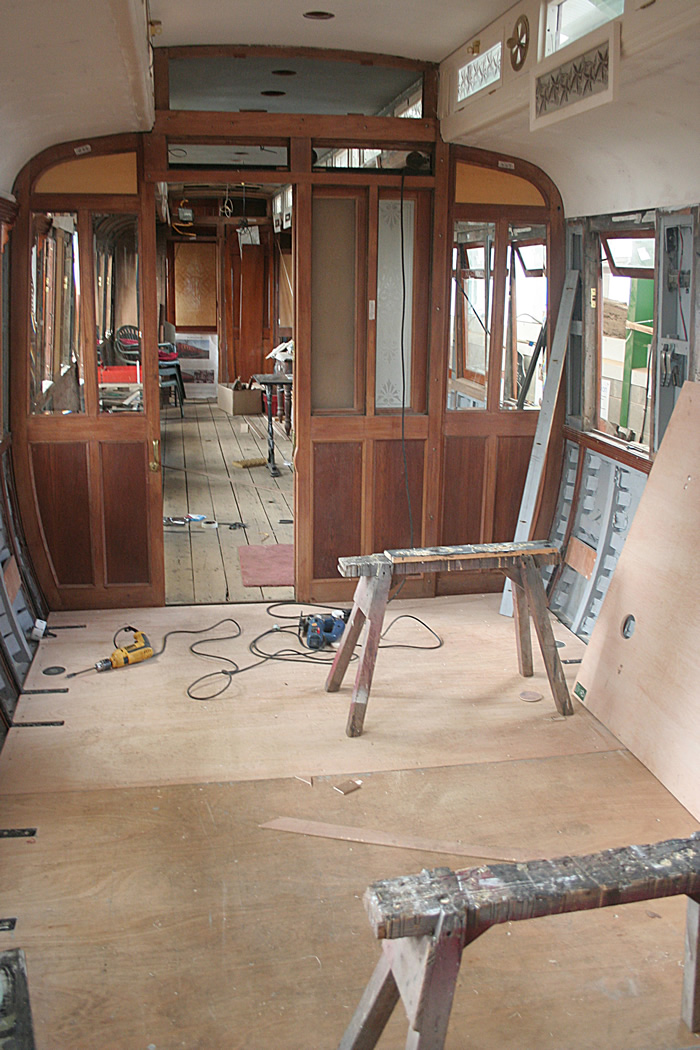
Inside East Coast Joint Stock Restaurant Third 189, plywood is being cut and screwed to the floorboards, whilst glass and mirrors now adorn the partitioning which segregates the saloon. Murray Brown
Covered Carriage Truck 1308: Not long to go now to reach completion. The final jobs are the end doors, both of which are being fettled and painted. It really looks magnificent in LNER Brown with white lettering, the latter skillfully applied by Mike Faulkner.
Bain (ECJS) Restaurant Third 189: The interior is slowly being transformed – new bevelled glass and mirrors have been fitted in the saloon’s partitioning. Plywood flooring is being applied to the bare floorboards, and thoughts are turning to how to make the chairs and tables. Photographs of 189 in its Edwardian heyday show the cast chairs to be ornate and opulent. The word ‘expensive’ springs to mind . . .
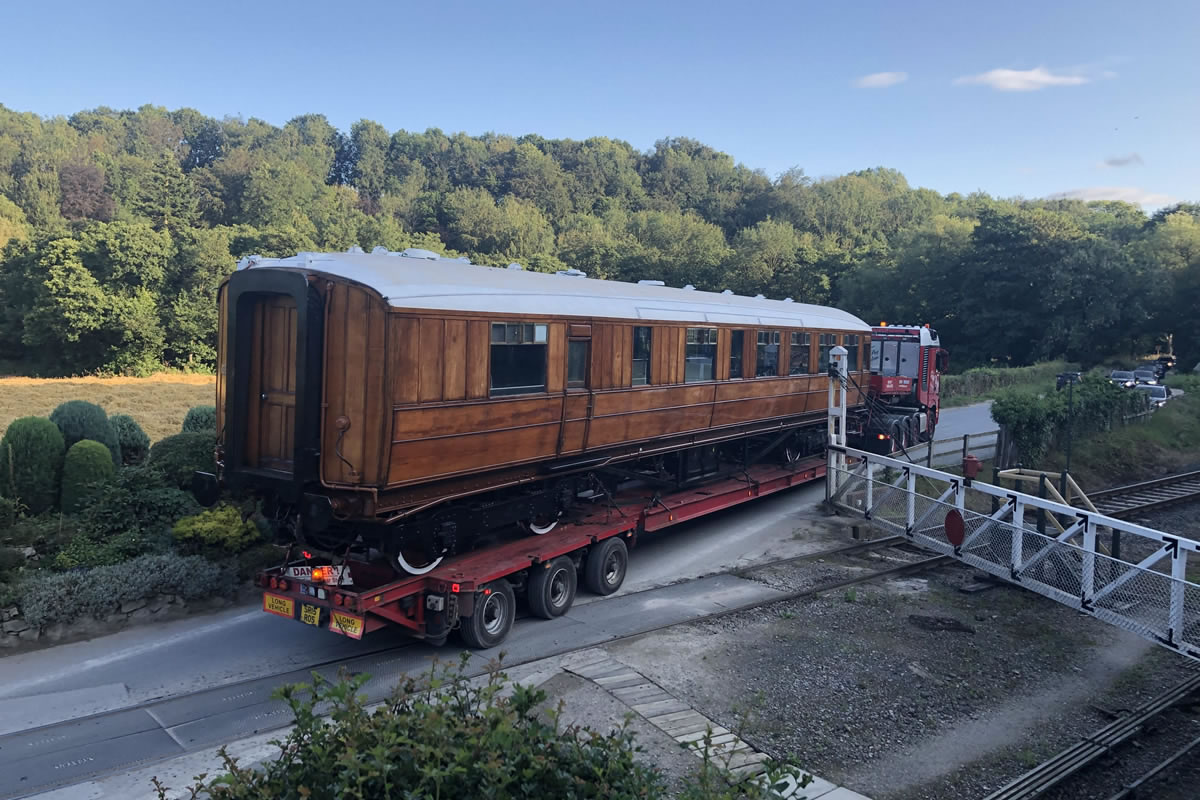
A welcome sight – the return of Restaurant Buffet 641 from Wirksworth where Lee Sharpe Engineering has undertaken a huge amount of body repairs and putting right the vandalism damage incurred at Pickering in 2017. It is passing New Bridge signalbox on August 7. Would you believe the transporter driver reversed the carriage all the way (one mile) from Pickering to New Bridge yard! Kitola Starr
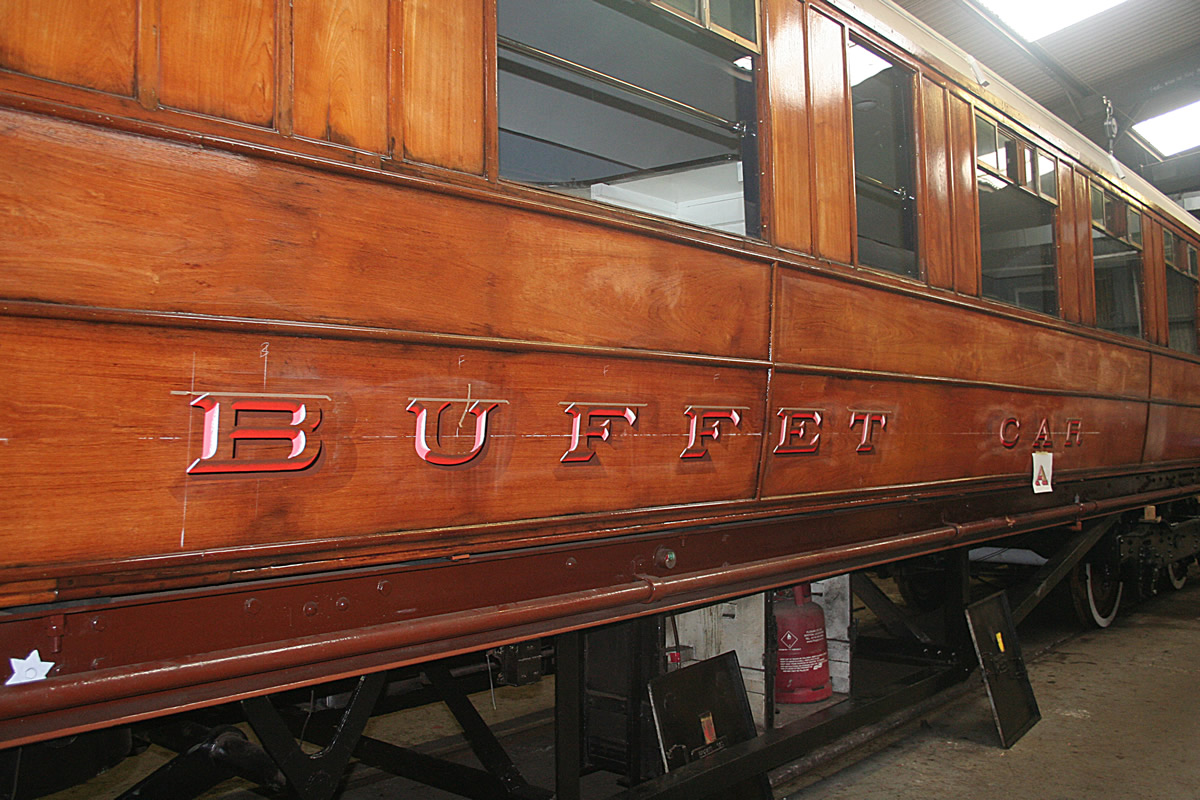
With Restaurant Buffet 641 back from Wirksworth following extensive rebuilt (after the appalling vandalism damage in 2017) and maintenance undertaken by Lee Sharpe, it is now in the main C&W workshop where new bearing brasses are being fitted to the wheelsets and the signwriting of ‘BUFFET CAR’ is being put in hand by Peter Whitaker. The brake rigging is also receiving attention due to the new tyre size thickness. Murray Brown
Prepare to be amazed!
As ever, we extend an invitation to all visitors to the NYMR to call in when passing the Atkins shed, adjacent to the car park on your next visit. We will be glad to show you around. Not only that, but we can guarantee any donations can be put towards the carriage of your choice if you have a favourite.
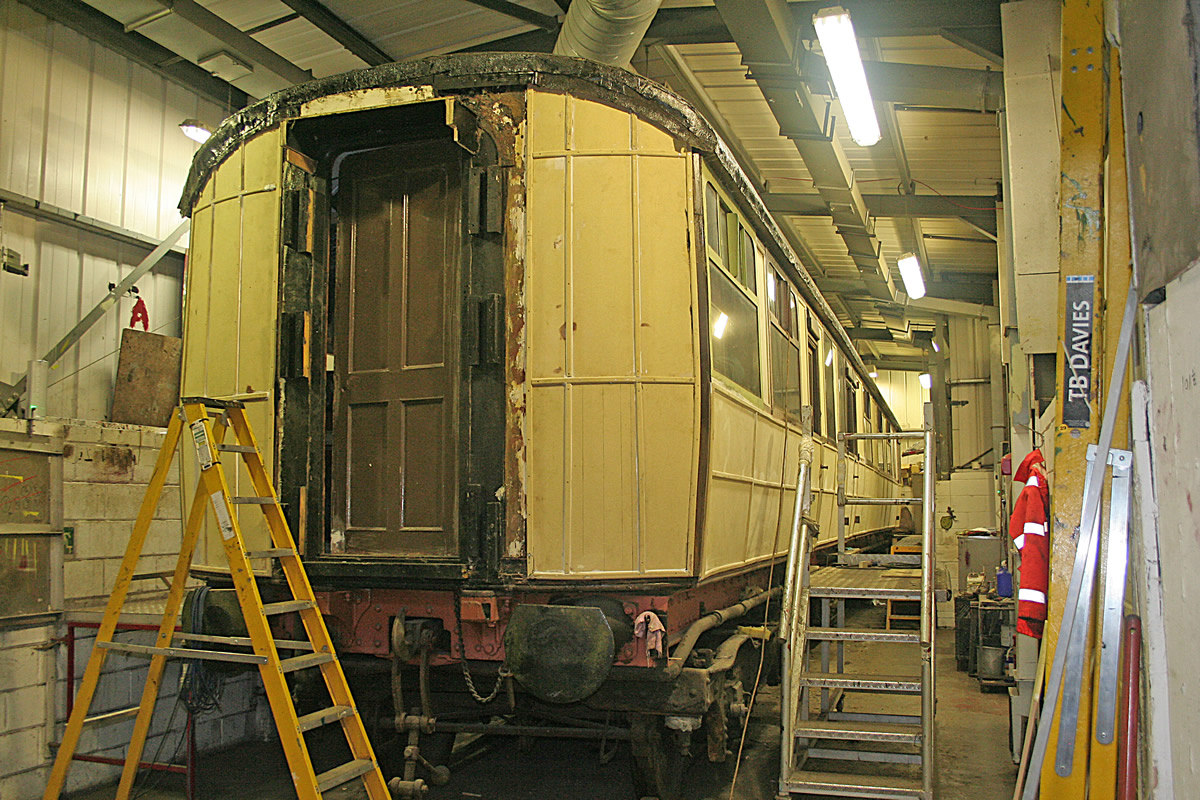
The LNERCA’s former Restaurant First 42969 which initially worked on the East Coast route and then on the Great Eastern Main line saw its fortunes tumble when it was converted to a Breakdown Train Staff Riding coach for use at Stratford. After being sold to the Woolwich Museum, it is now used as the upholstery store by the NYMR C&W staff. Its body is being fettled prior to being painted in LNER Departmental Blue – this will be a ‘first’ in railway preservation circles. It is believed this is the first time 42969 has been under cover since it was converted to Departmental use in 1963. Murray Brown.
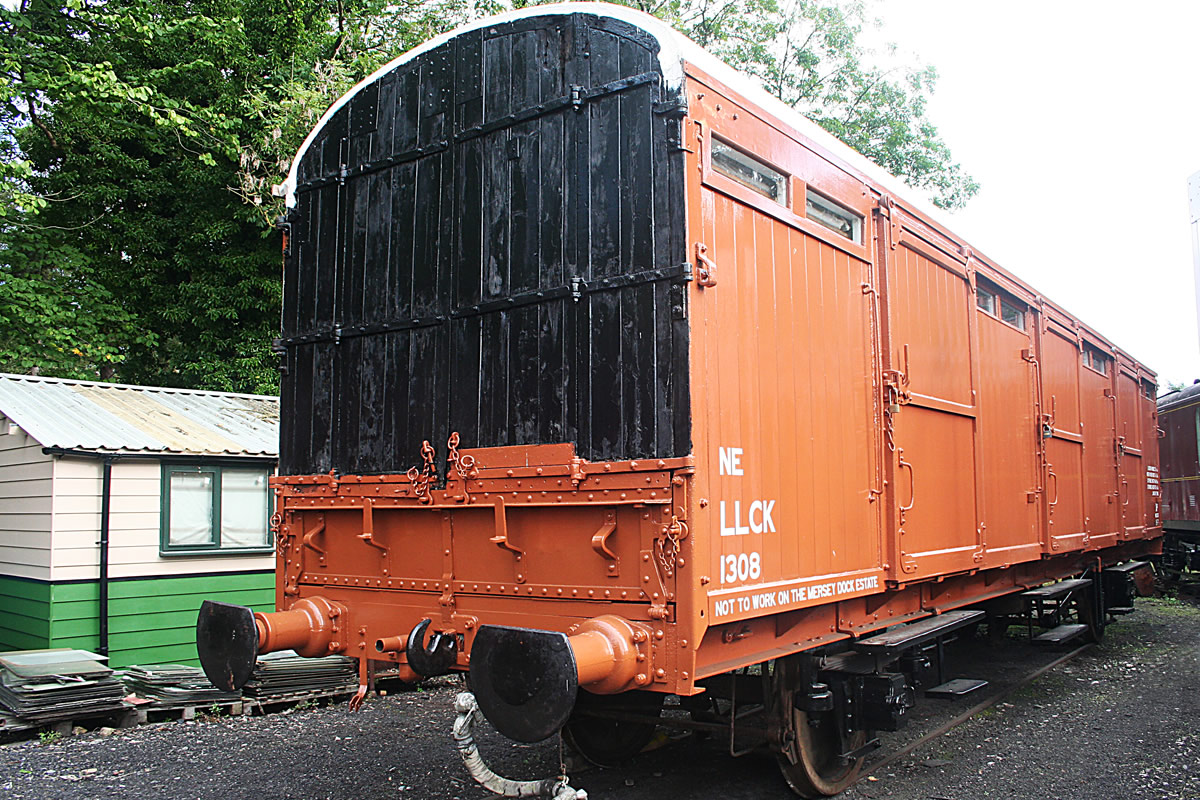
Looking good – the LNERCA’s CCT 1308 is well on the way to completion. All the lettering is now completed, stepboards fitted, with just the end doors to renovate and paint LNER Brown to match the rest of the vehicle. Murray Brown
STOP PRESS
Four LNERCA coaches to leave NYMR whilst carriage shed is built
One of the major planks of Yorkshire’s Magnificent Journey lottery-funded project is the provision of a carriage ‘stable’ to be situated on a field on the west side of the line just north of Trout Farm crossing, a quarter mile north of Pickering station.
Preparatory work for the new carriage shed is well under way, to ensure that it is finished by May 2021. One consequence is that it is necessary to clear the Pickering Long Siding for the ground works to commence which includes slewing what is the Long Siding. This means some of our vehicles need to move away from the NYMR temporarily because there is nowhere else on the NYMR to store them. Four of our vehicles (NER Third Open 945, Gresley Tourist Third Open 24109, Gresley Third Corridor 23896 and Thompson Composite Corridor 18477) will be moving to Spennymoor, Co. Durham, where they will be stored under cover for the first time since being rescued for preservation. They have been selected due to being partly restored. The costs of their move there, and in due course back to the railway, are being funded by the railway. The LNERCA has a written Agreement with the NYMR Trust Board, signed by the Trust Chairman, that these vehicles will return to the NYMR once the carriage shed is built.
Since all four of these coaches are in a semi-restored condition, this gives the LNERCA a great opportunity to recommence work on them, if funding for such work could be found. Already up there is Thompson Composite Lavatory 88339, waiting a detailed inspection to assess the necessary door repair work. Thus the LNERCA is looking for anyone willing to consider a major act of sponsorship? Getting another of these wonderful carriages working again would be appreciated by so many of the travelling public. If anyone wishes to visit the site at Spennymoor, which is private, please do contact the LNERCA Chairman, Nick Stringer who can make the arrangements. His email is: nickstringer701@btinternet.com
TTO 24109 transfers to LNERCA’s fleet – July 2019
Top news this month is that Colin Sykes has transferred the ownership of Tourist Third Open No. 24109 to the LNERCA.
Colin holds a special place in the annals of the LNERCA, for he was the first to respond to an appeal when the LNERCA was formed in 1979 to become part owner or full owner of a LNER carriage. Colin, who lived at the time at Glenrothes, Fife, wanted to buy a Gresley and managed to secure 24109, then numbered departmental TDE 320956. He bought it from scrap processor CF Booth, Rotherham, to whom it had been sold by BR, this carriage being one of the former secret mobile control train carriages – to be used in future wartime to control rail operations.
Restoration commenced in earnest and Colin spent hundreds of man-hours painstakingly renovating the carriage – for many years it was domiciled in Pickering yard. Where did the years go? With Colin taking over running 17 Burgate Hotel, Pickering, time disappeared for working on 24109. Then his good lady had to withdraw from her cooking duties – Irene was renowned for her culinary expertise – and the couple retired to Lealholme on the Esk Valley branch. Colin still managed to volunteer in Grosmont café.
Meanwhile, 24109 migrated to the Long Siding, Pickering, awaiting completion – and now resurrection.
The north end framing needs completing and almost certainly a new roof canvas will be required. The largest job will be the provision of seating – but times have moved on in 40 years and the advent of CNC technology (computer-aided automation of making wooden components) will bring the cost down.
Further news on this carriage – which many of the regular LNERCA volunteers would dearly like to see completed – may appear in the news bulletin in August.
CCT looking resplendent
After several months inside the Atkins shed, CCT No. 1308 is now parked outside near the turntable and looking absolutely magnificent in its LNER brown and white roof.
Attention has now turned to the headstocks at each end – stripping old paint off, then repainting in anti-corrosive green, grey undercoat and top coat. One of the ‘tailgates’, the metal plank which folds down to allow vehicle access (CCTs were often used to convey cars and vans), has been removed to be similarly treated, with the one at the northern end to be dealt with in similar fashion.
Meanwhile the metal supports for the footsteps have all been prepared and painted black. New stepboards have been procured, cut to size and painted – these will be bolted onto the supports imminently.
The last main job is the removal of the end doors so that the framing can be renewed as necessary.
Mustn’t forget the lettering. The white lettering – in LNER style and not BR – is being applied by wagon restorer, Michael Faulkner. This CCT will turn heads when fully completed and deservedly so – a credit to all the LNERCA and Wagon Group volunteers who have worked on it.
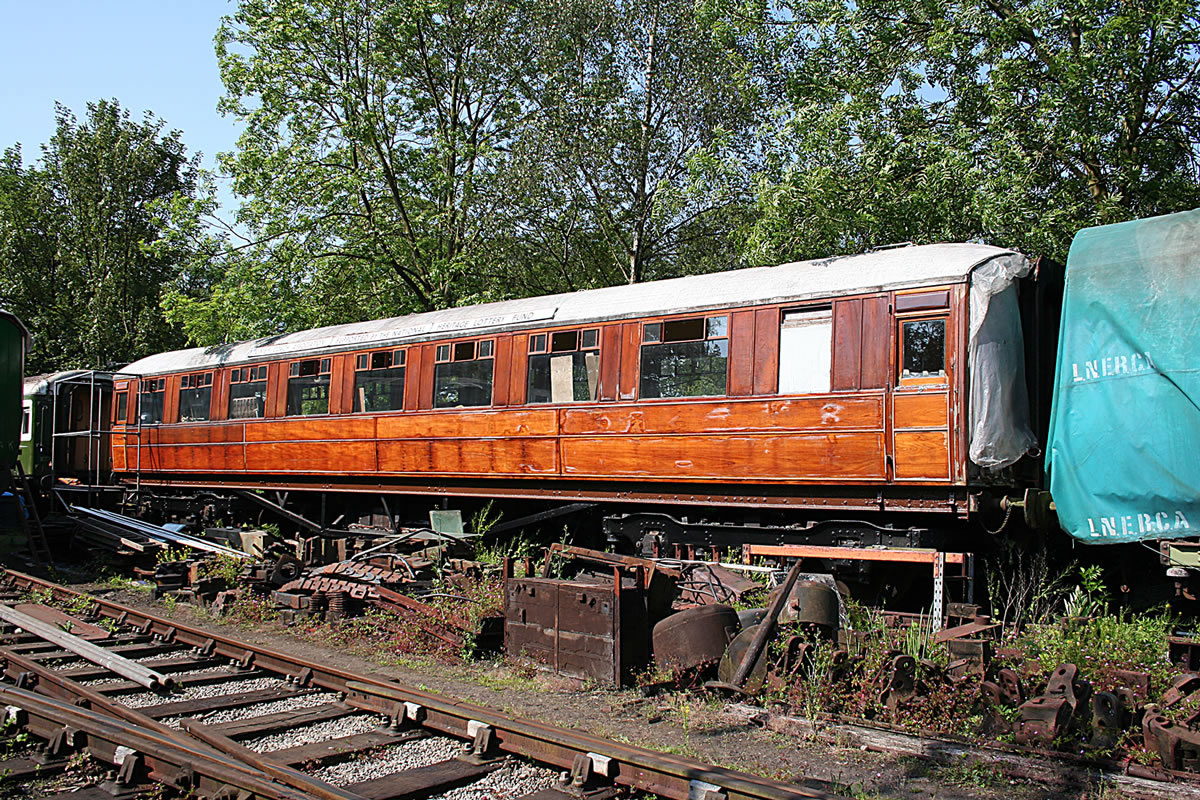
Flashback to 2006 when 24109 was last in Pickering yard. This June 6 picture of that year shows the tarpaulined Thompson TK 1623 to the right and the Mk.3 Sleeper 10591 is to the left. 24109 and 1623 occupy the space now taken by the Atkins shed.
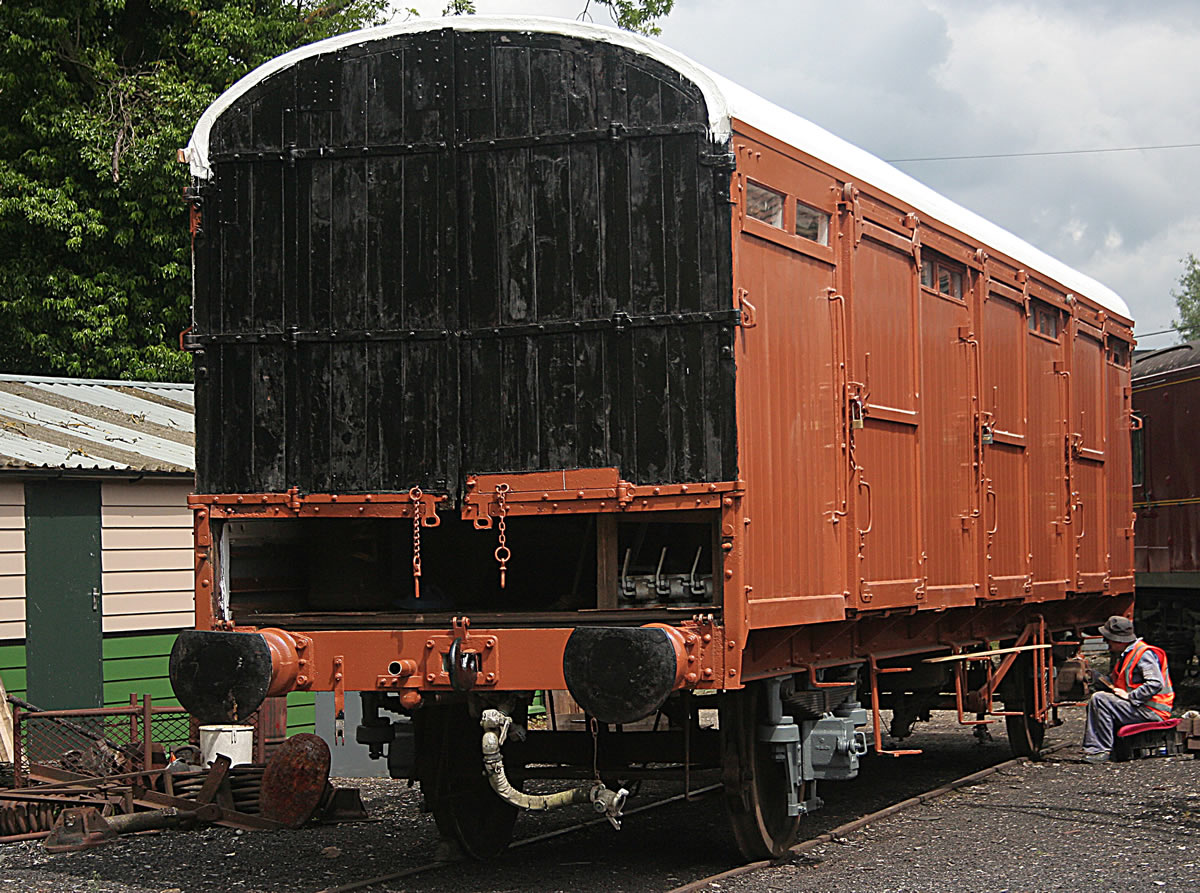
Looking good: After months inside the Atkins shed making the CCT watertight, 1308 is back outside and residing in its former location – alongside the LNERCA’s workshop. Here the headstocks are being painted and the wooden framing at each end will be removed and refettled.
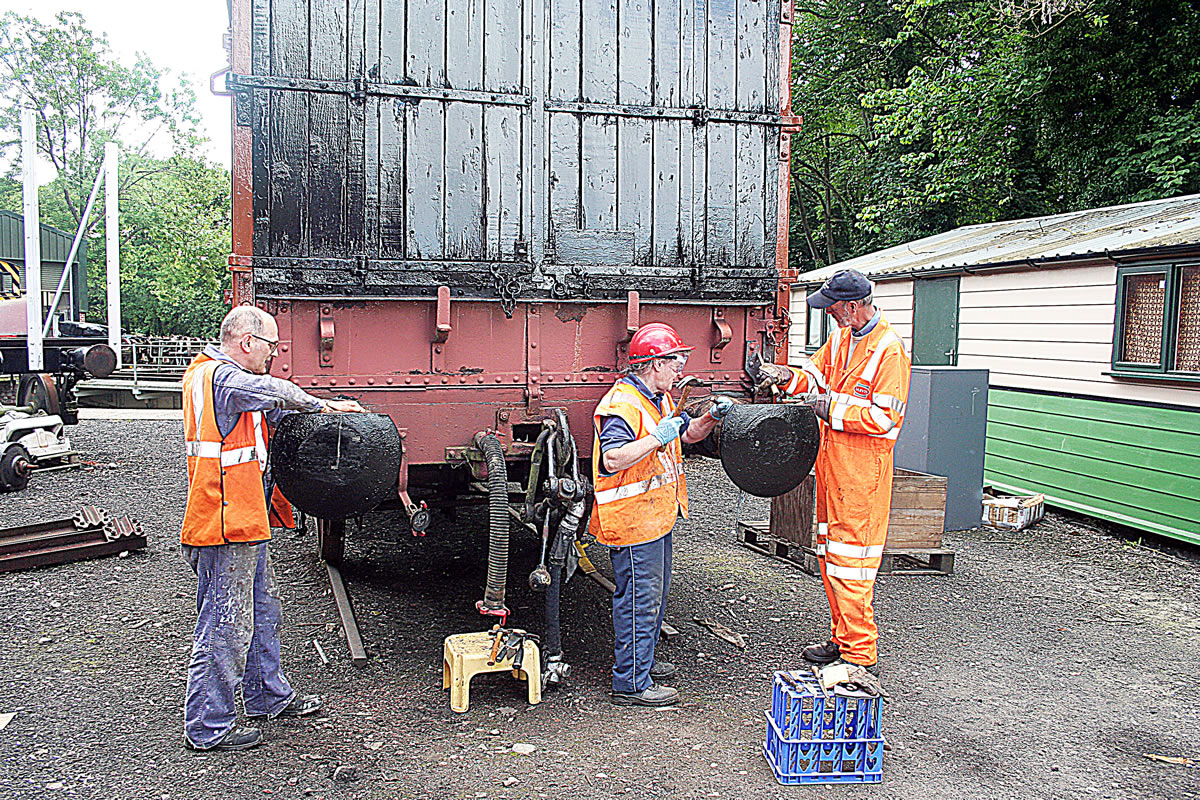
Chipping old paint off the Covered Carriage Truck’s north end headstock on June 30 are regular Sunday volunteers from left to right, Nick Smith, Doreen Williams and Stuart Hiscock.
Now that the CCT is outside, a perk of the job is being able to watch the trains pass by. No. 1308 spent many years at this location since being donated from Doncaster Works in July 1996.
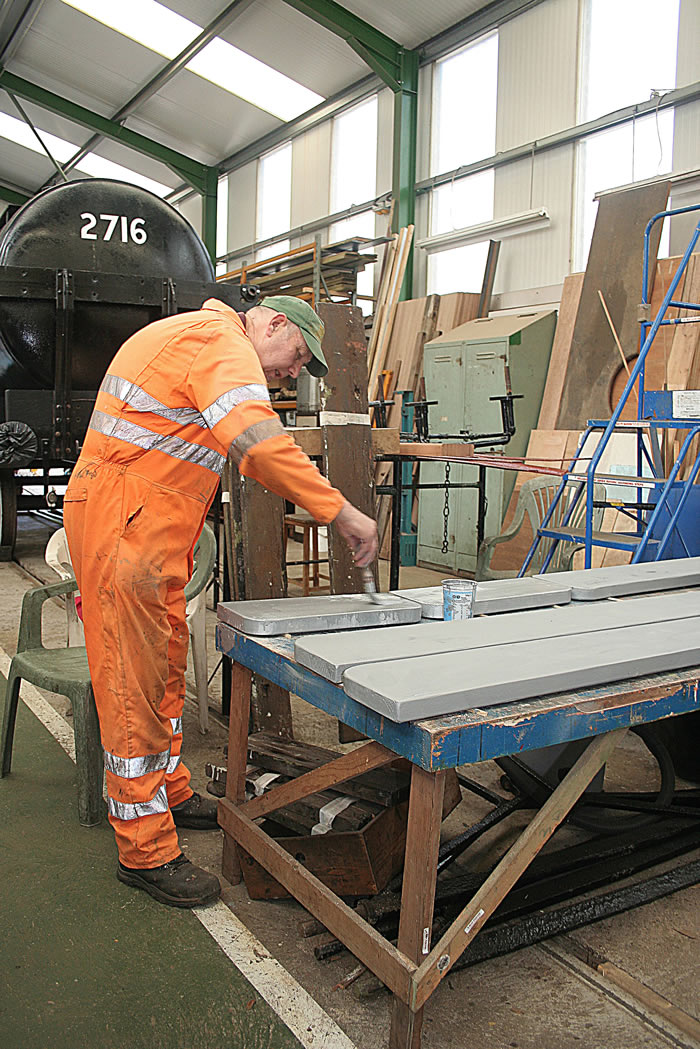
With new stepboards for the CCT procured, they have been cut and shaped to size – Mick Watson applies the first coat of aluminium wood primer.
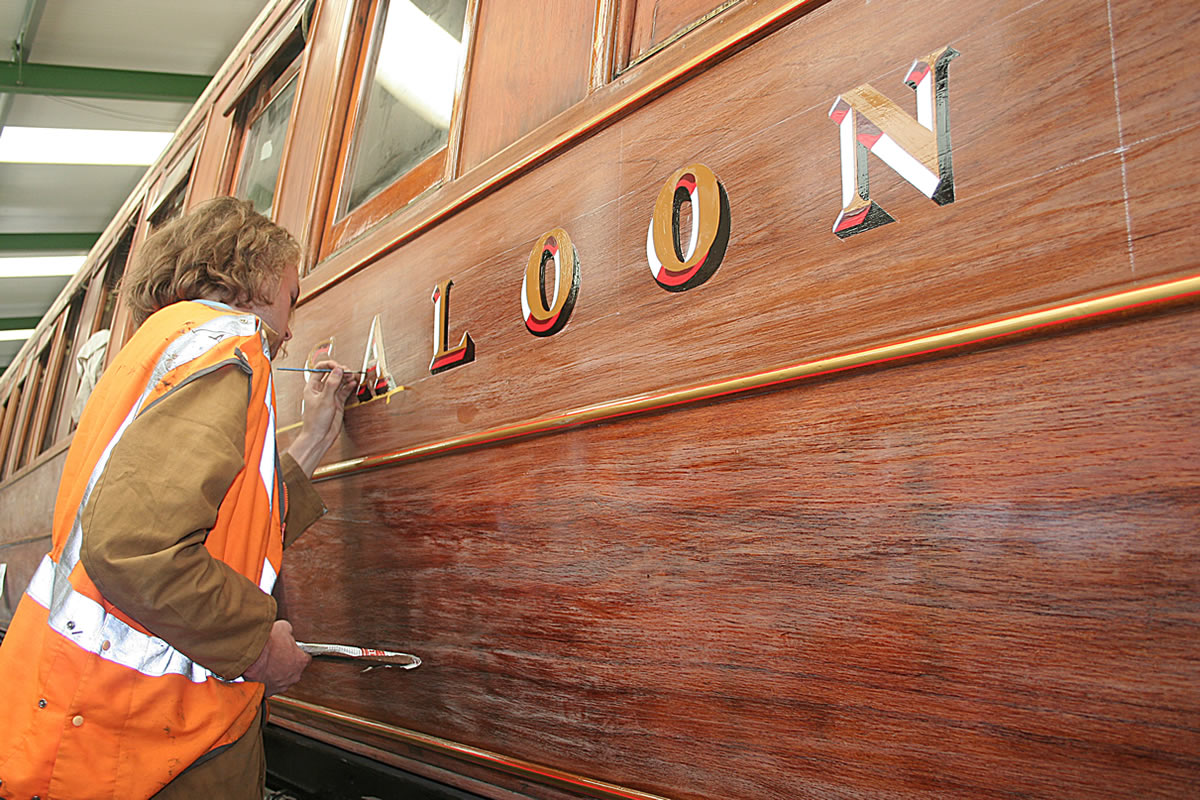
Painting patience personified: Chris Johnson continues the painstakingly slow task of signwriting the lettering on East Coast Joint Stock Restaurant Third No. 189.
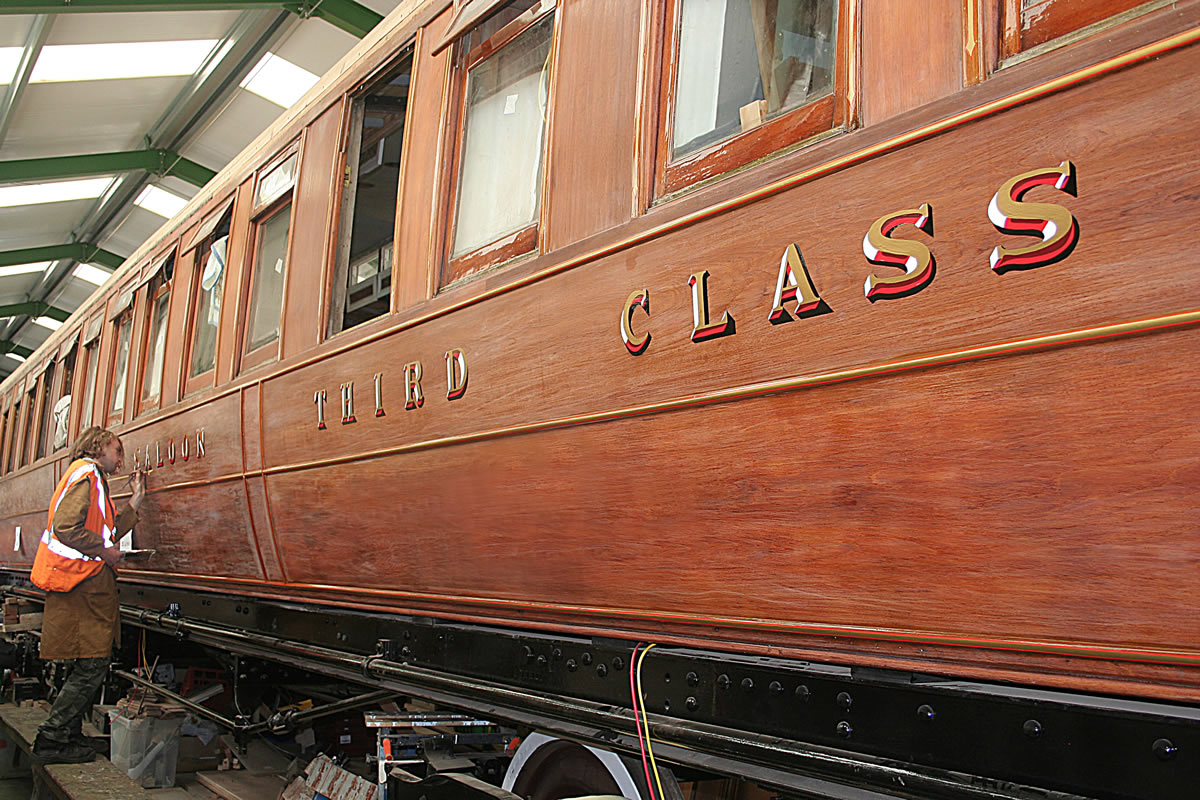
This view portrays just how magnificent the finished product will be one day as more of the lettering is completed by the LNERCA’s Tyneside volunteer. Once the lettering is complete, some seven more coats of varnish will be added to the three already applied, prior to the start of the lettering.
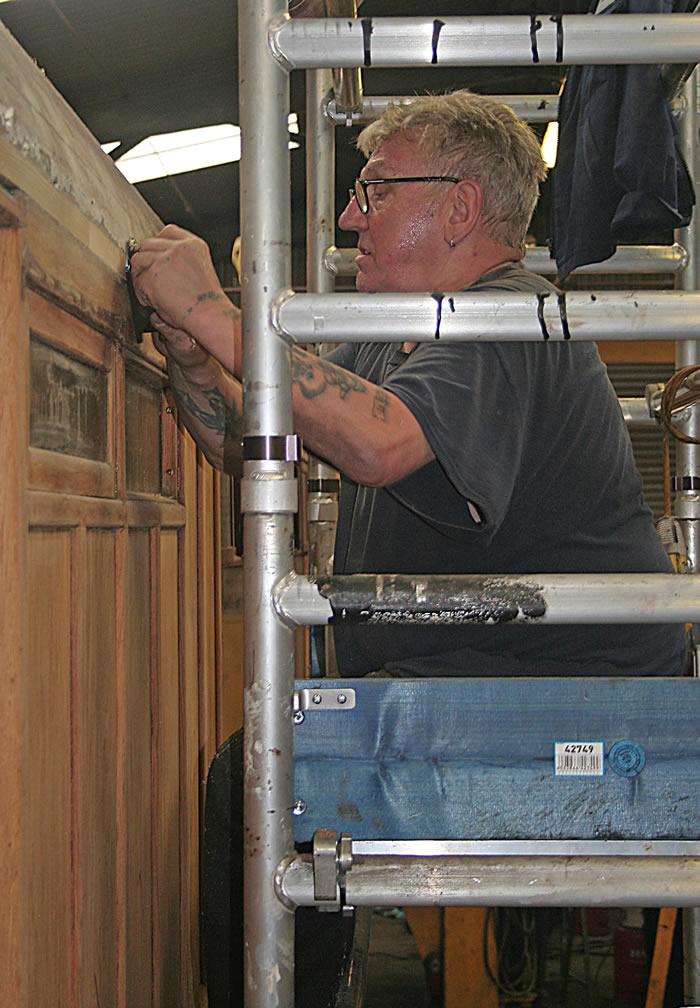
Our newest ‘recruit’ – Jim Chittock. The LNERCA is most fortunate to acquire Jim’s expertise – in a previous incarnation he worked as a coach builder at York Works and in the preservation era has worked on the restoration of the ‘Brighton Belle’ electric multiple unit carriages, currently at Langwith Junction.
Jim’s first job with the LNERCA was to splice in a fillet to replace a rotten section of the cantrail of Brake Third Open No. 43567 – this carriage is in the main C&W workshop.
CCT’s doors all fitted – June 2019
Both sides of the CCT E1308 (or just 1308 as it will be renumbered without the ‘E’ prefix) are complete, with the fitting of the last sliding door.
It was the intention to wait until the CCT had been moved outside in order to allow the C&W’s all-purpose lifting vehicle to raise the rather heavy doors into position. However, it was found that by using several burly men, each door could be lifted and hung. The CCT is now ready to be moved outside – and so allow the Pickering Wagon Group back inside – the CCT having taken its space. The LNERCA is most grateful to the Wagon Group for allowing their space to be used in order to get the CCT watertight. A third coat of white water-resistant roof covering has been applied. Once outside, the end doors can be lifted off for refettling – because of their weight, this will definitely require the assistance of the C&W’s teleporter.
Springs come off Fish Van E75169
Three of the four springs have been removed from E75169. The fourth will shortly join them – all four will eventually be taken to Owen Ltd, Rotherham, for checking as regards tempering or renewal as required. This will not take place until funding is available.
DC Engineering has confirmed it still retains at least three components from the brake rigging which were not returned to Pickering when the underframe came back – this is quite a relief.
It now means that assembly of the brake rigging can proceed as soon as these parts are returned.
An order has been placed with Armstrong Oilers at Grosmont for four new oil pads – as recommended by the Pickering Wagon Group. Indeed, it is right to thank and acknowledge all the assistance and advice given so far by Ian Broadhead, leader of the Wagon Group.
Varnish applied to east side of ECJS No. 189
Neil Cawthorne, after much preparation of the teak panels and beading, has started to apply varnish to the east side of No. 189 – the rail side of the carriage as opposed to the car park (west) side. In a couple of isolated places, there has been an odd reaction to the varnish, resulting in tiny blistering. With his years of experience in varnishing and lacquering, he is confident all will be resolved.
Meanwhile, the long intricate job of free-hand painting the lettering EAST COAST DINING SALOON THIRD CLASS on the west side continues – by Chris Johnson. This talented young man sets exceptionally high standards with his painting expertise.
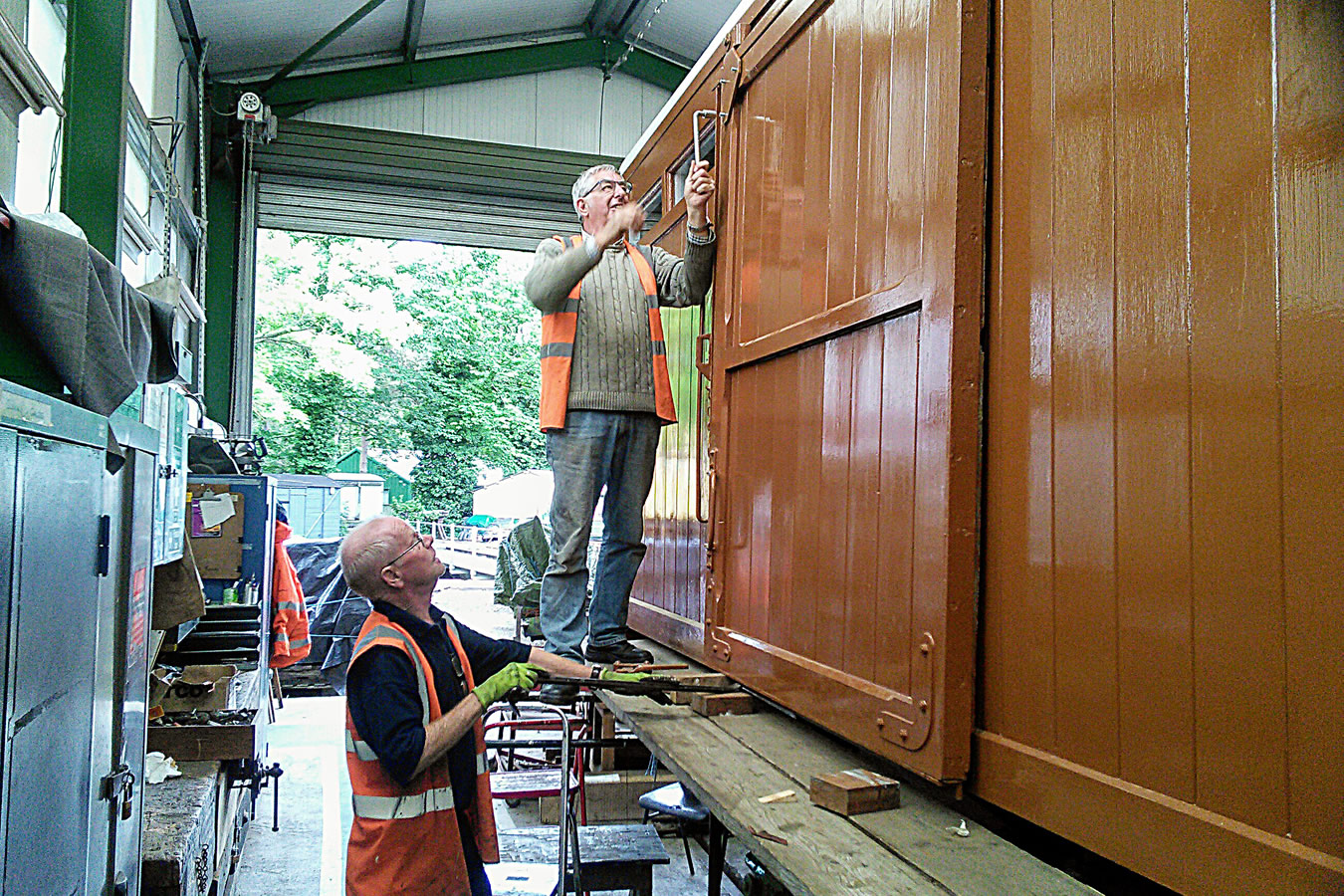
Brian Ford (top) and Ken Richardson fit the last door to the CCT. Everything you see on this door, apart from the metal fixings, is brand new – as is all the bodywork along both sides of 1308. The roof is also now finished. The CCT is destined for the great outdoors shortly. Photo: Philip Brunsdon.
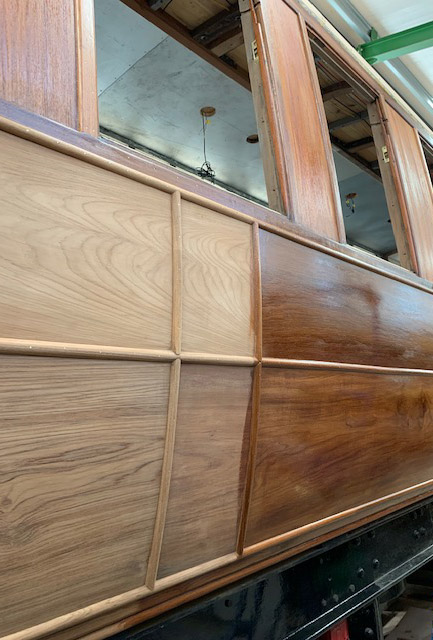
First varnish on the east side of ECJS No. 189, clearly showing the immediate transformation from bare teak to that of the first coat of varnish.
Only ten more coats to apply. . . . .
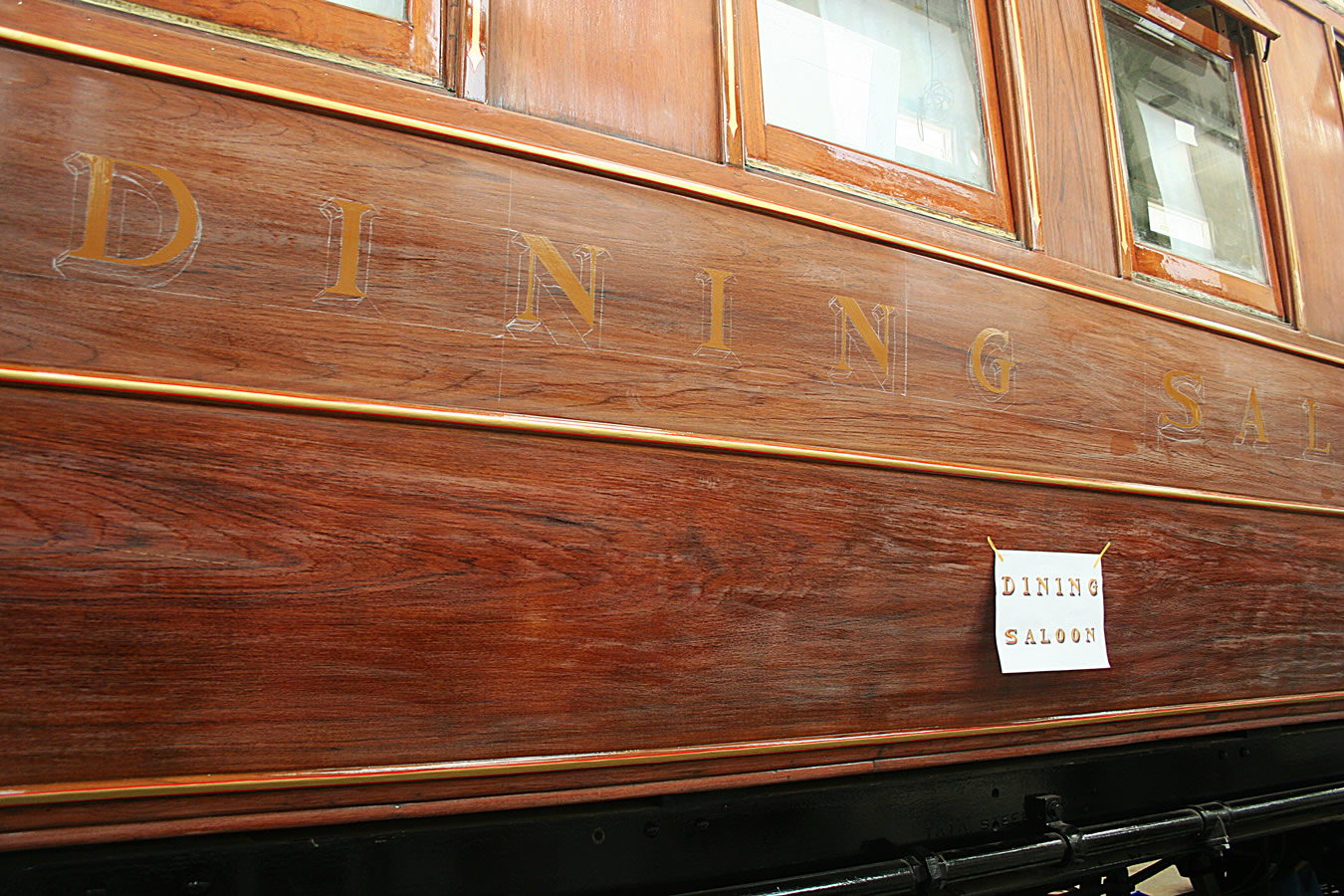
Impressive eh? Chris Johnson’s handiwork is shown to good effect as the long job of painting all the lettering progresses. And there is the other side of the carriage to sign write as well!
Photo: Murray Brown.
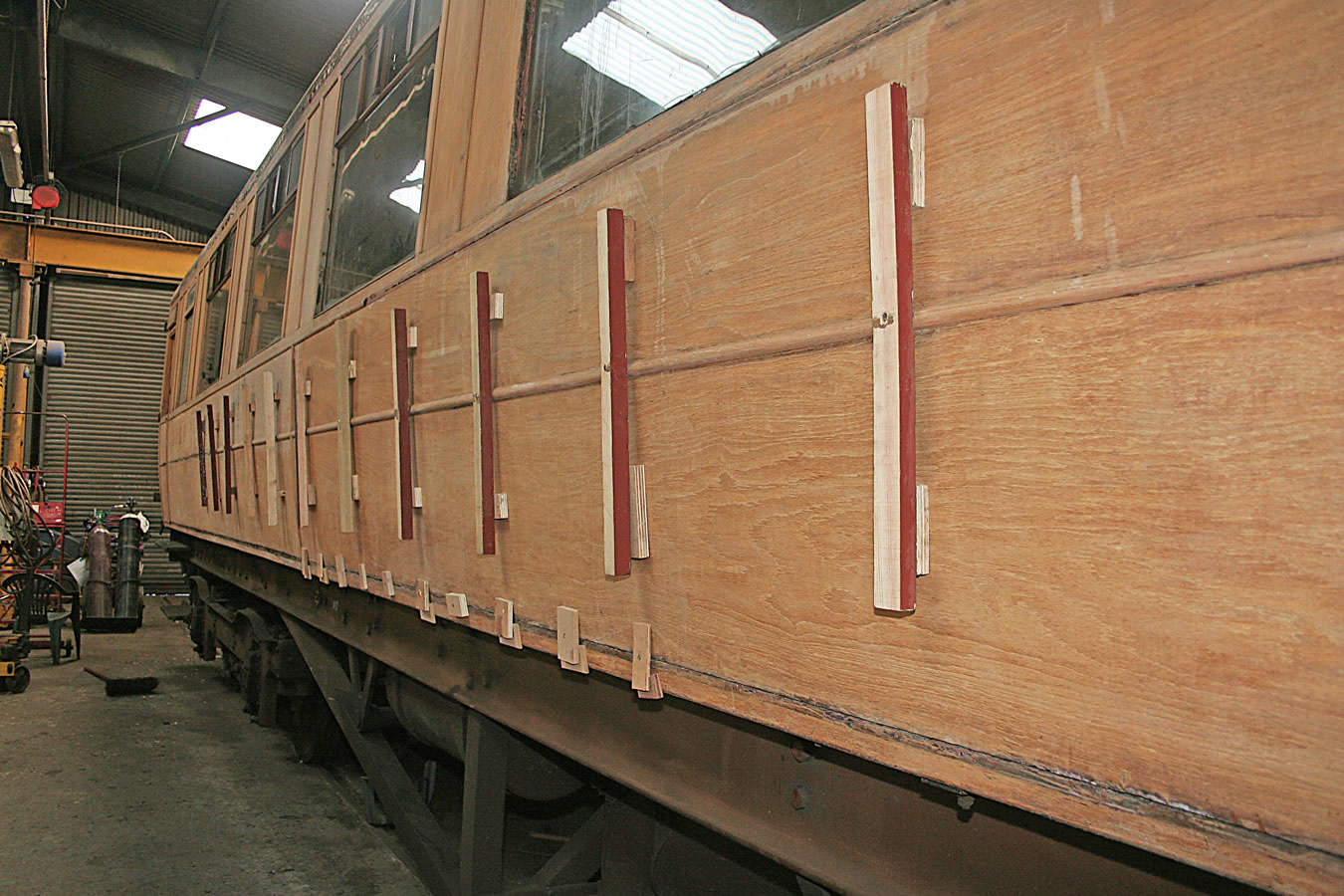
Besides a total strip of all varnish on Brake Third Open No. 43567, repairs to loose panels have also taken place. In this view, it can be seen how the panels are held in place against the internal teak framing whilst the triangular glue blocks which hold the panels onto the framing harden and set. Photo: Murray Brown.
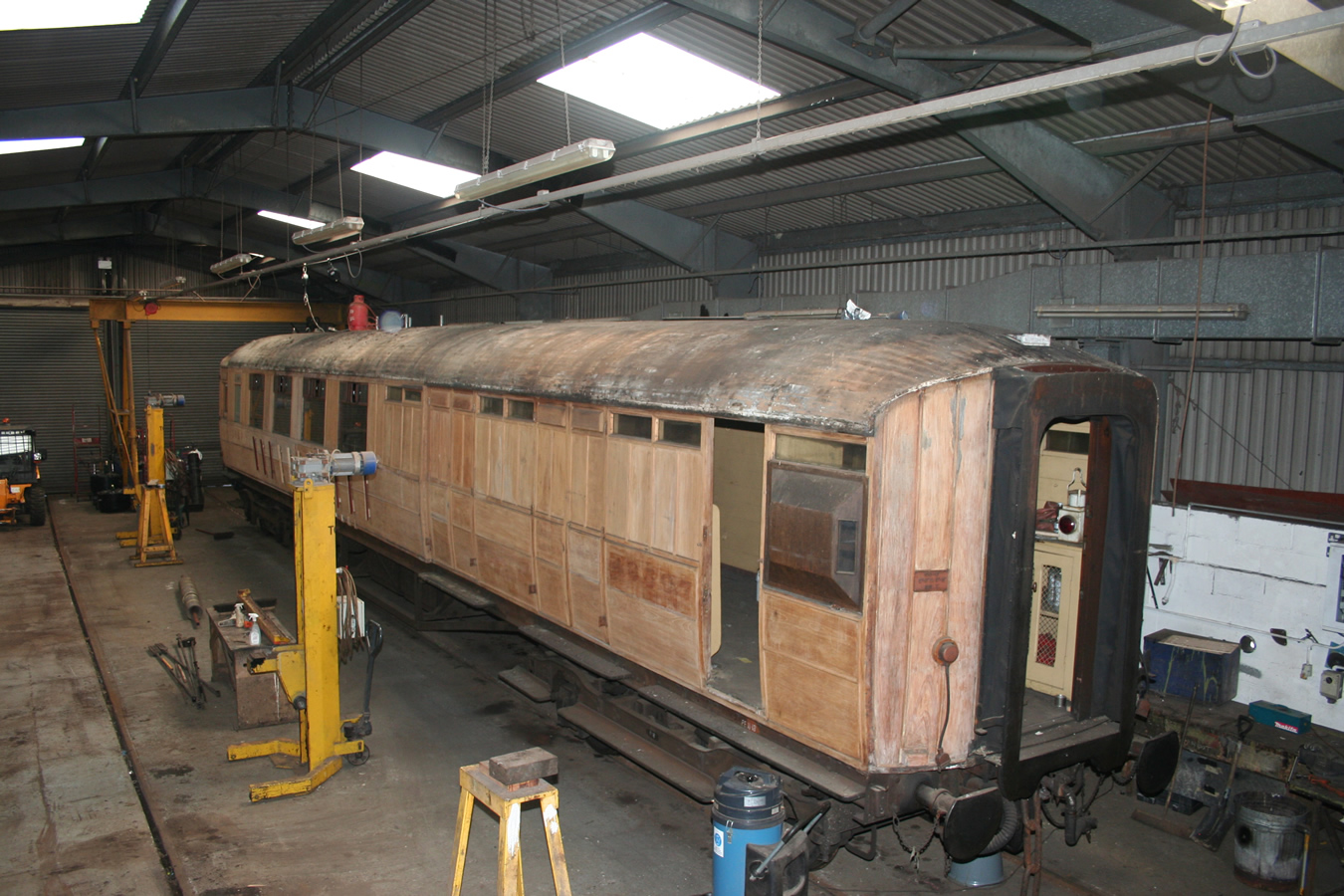
Inside the main C&W shed, BTO No. 43567 is now devoid of all varnish – and roof canvas – a complete strip to bare wood. This has been such a dispiriting task for volunteers. Water ingress on the failed roof covering and on the bodyside has meant hours of remedial work. The roof is planned to receive the new polyester material as trialled on the CCT No.1308. Photo: Murray Brown.
White roof for CCT 1308! – May 2019
For the first time in its existence, Covered Carriage Truck (CCT) No. E1308 has a white roof. This has come about because the valiant, trusty stores van, so vital to the work of the LNERCA, is receiving a substantial body overhaul and, because it is being put back into LNER livery, this explains why the bodyside panels and doors are now in LNER brown, whilst the roof is white.
Of course, there is a little artistic licence here in that as No. 1308 was part of the second batch of CCTs built in 1950, it would have emerged from Doncaster Works in maroon. The first batch of CCTs built by the LNER in 1939 was, of course, in LNER Brown. The latter batch was identical to the first and the LNERCA committee thought that we would ring the changes, especially as the CCT will be on show to a large number of visitors to the NYMR as they make their way past the station to the car park. No. 1308 is destined to be placed in what is known as the Beck Siding – highly visible from the road past the station and to passengers on Platform 1 at the north end of Pickering station.
Work has nearly finished on the extensive body overhaul as regards the sides of the CCT. The ends have yet to be tackled and these will be done once the van is extracted from the Atkins shed to allow the C&W’s ‘all-purpose’ vehicle to lift off the heavy doors to enable frame repairs.
The LNERCA committee would like to place on record its thanks to the Pickering Wagon Group whose members have given of their time in large amounts to help with the bodywork repairs on No. 1308.
Worthy of mention is the repair of one of the door pillars – this was practically non-existent, with just a stump hanging down from the cant rail. An entirely new pillar has been fabricated and spliced into the remaining piece. This necessitated using an Acrow Prop to support the ceiling whilst the work was in hand. New vertical boards have been fitted along the entire west side (car park side) and painted. A superb job has been done by many LNERCA volunteers and the CCT will look outstanding when finished.
Work resumes on Fish Van E75169
Fingers crossed, we are expecting our joiner to be able to start work in the foreseeable future once he has finished his contract work on the LNER ‘Beavertail’ carriage at Burton on Trent.
The brake rigging, much of it already derusted and fully painted, has been resurrected. In addition, two axlebox covers have been dropped to examine the ends of the axles (journals) and to order four new oil pads (one for each axle) from Armstrong Oilers at Grosmont. The two journals examined so far were found to be in excellent condition, with no evidence of scoring.
Meanwhile the newly overhauled brake cylinder is being prepared for fitting. We have also been promised some 2” pipe which can form the vacuum pipe which, of course, runs from one end of the vehicle to the other and is connected to the vacuum cylinder.
Moves afoot with Thompson CL 88339
At long last, there is some positive news we can report on the sad saga of the Thompson CL No. 88339. With the commendable decision taken by the members of the consortium which owned it to place it in the care of the LNERCA, the unique and highly relevant to the NYMR carriage left on a transporter to be moved to DC Engineering, Spennymoor. There an inspection will be undertaken to assess what repairs are necessary. It is likely the doors will be brought back to Pickering for rebuilding.
It is good to report that the NYMR will be contributing towards its repair and has guaranteed that No. 88339 will be used on the north end of the LNER set in which it resided perfectly well for several years – and was highly popular with the general public.
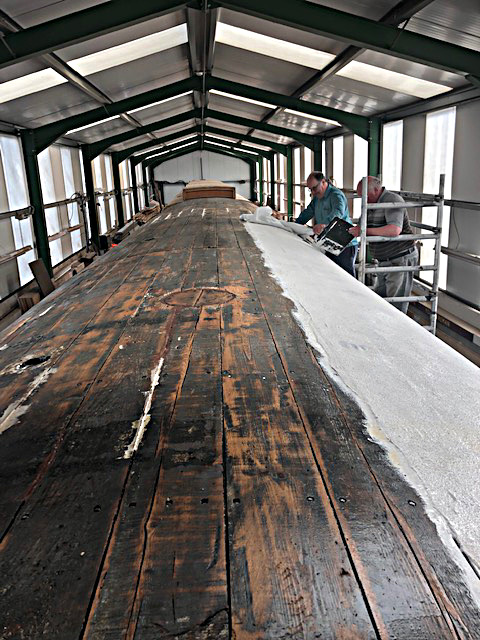
Being tried out for the first time is a polyester material because it has become apparent that cotton-based roof sheets used in past years are deteriorating, becoming rotten, and then letting in water.
The material is bedded in with a water-repellent paint rather like whitewash. The first roll of this material is pictured being applied.
Photo: Kieran Murray.
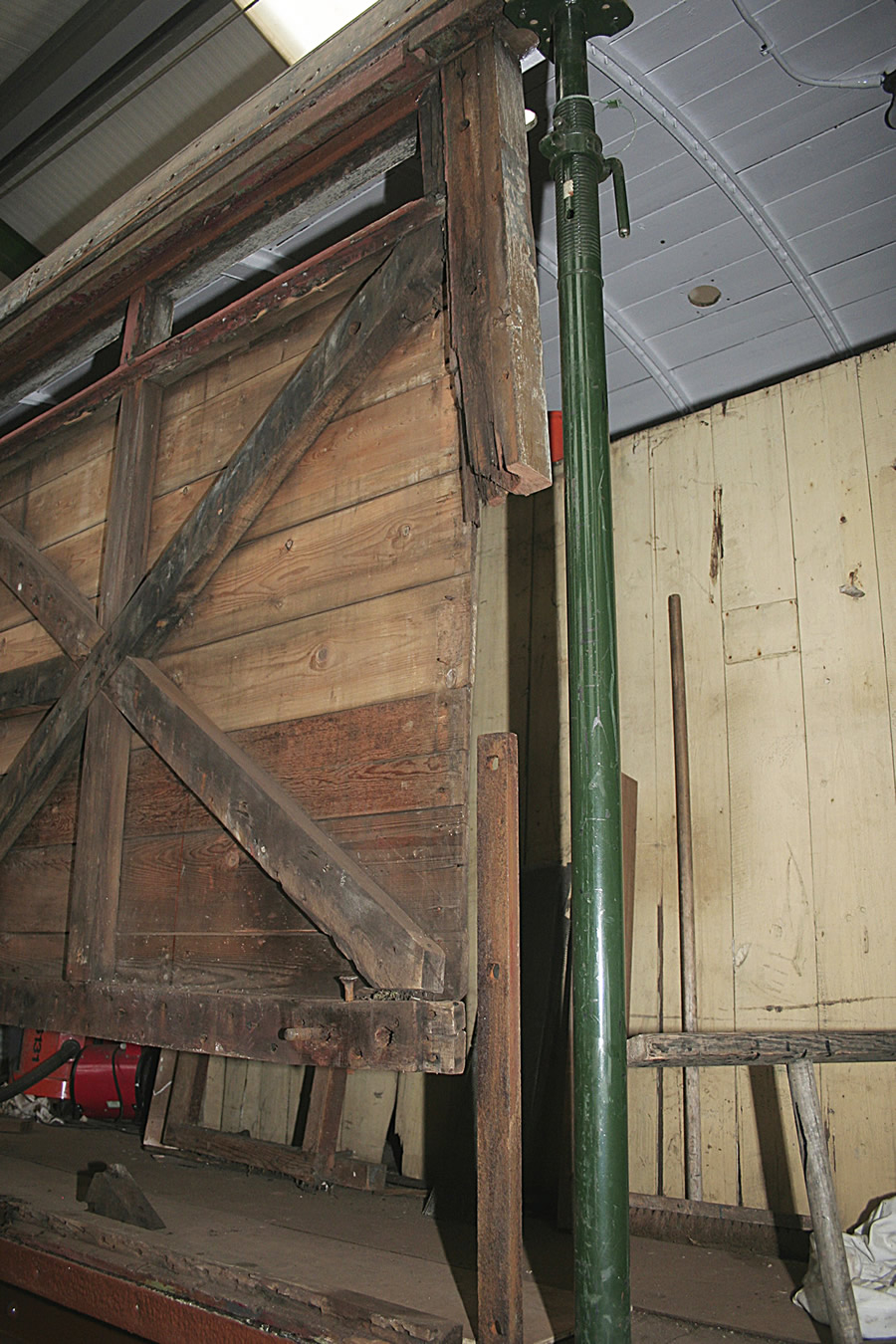
This was the state of a door pillar on the west side of the CCT – the two-foot remnant can be seen hanging from the cantrail. Until this pillar was repaired, the adjoining vertical-panelled side could not be completed. Whilst repairs were effected, an Acrow Prop was utilised to support the cantrail. Photo. Murray Brown.
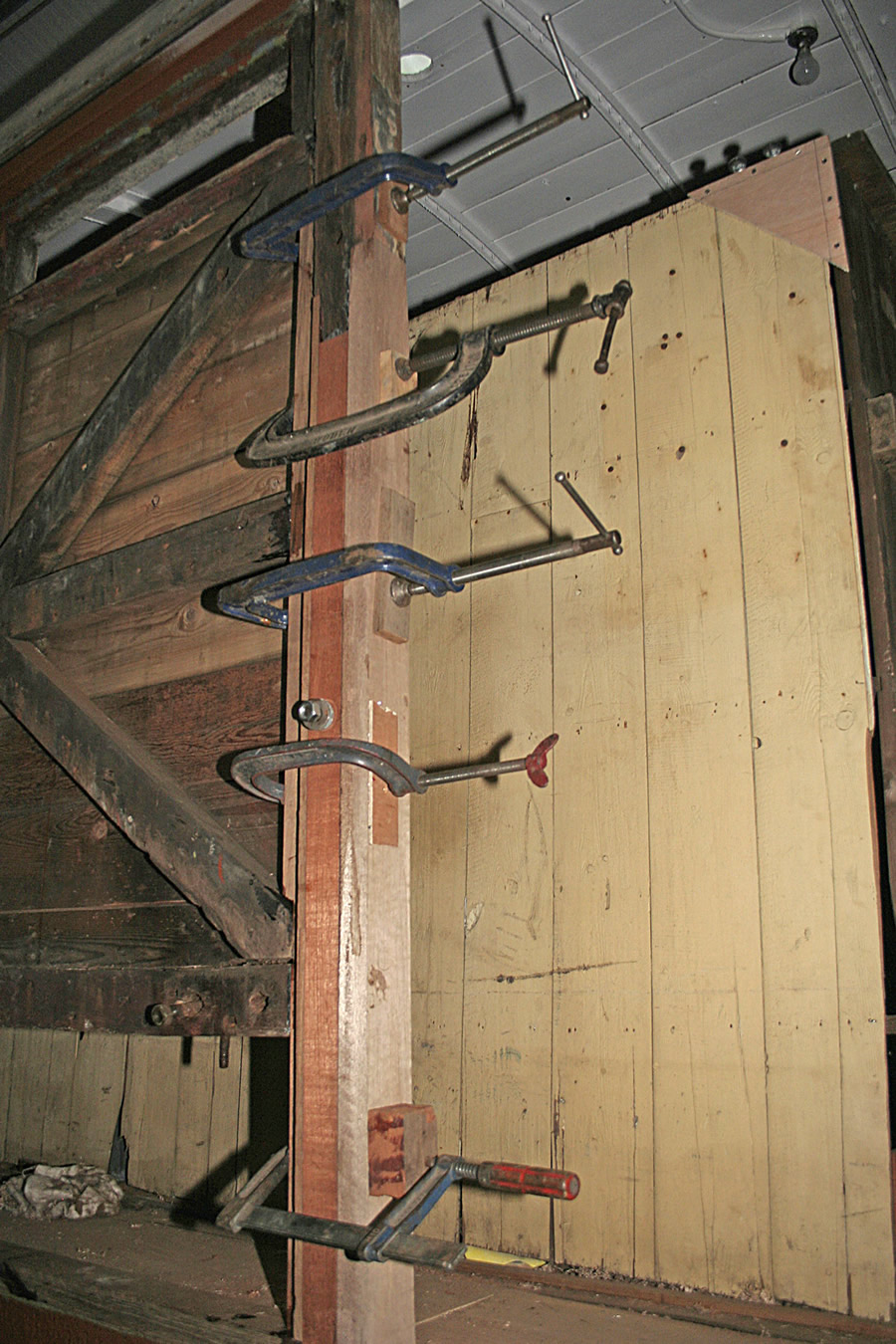
Job done! The new pillar which comprised various sections of specially cut wood including what was left of the original pillar is pictured waiting for the glue to set. This was by far the largest and time-consuming job undertaken on the CCT, so full marks go to Marcus Woodcock. It was also satisfying to remove the green Acrow Prop. Photo. Murray Brown.
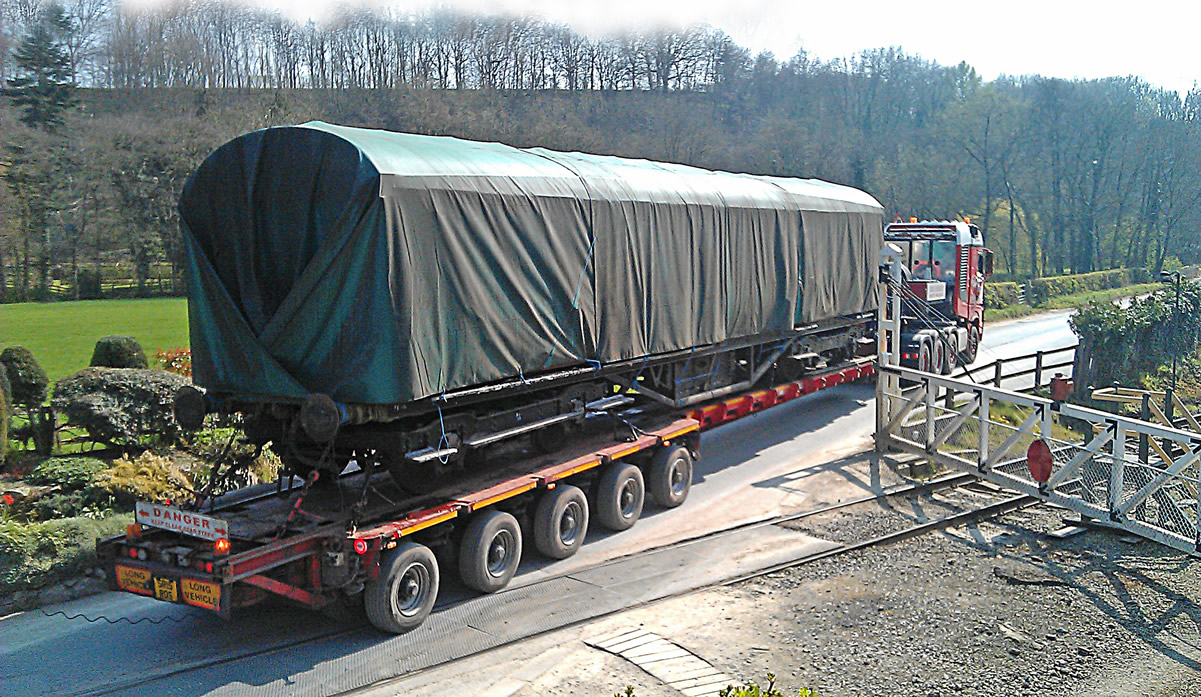
A new chapter in the 72-year old Thompson CL No. 88339 beckons. It is pictured passing New Bridge signalbox on April 18 destined to DC Engineering’s facility at Spennymoor for storage under cover and assessment for remedial repairs. The good news is that it is coming back to the NYMR and will definitely be used. Photo. Peter Wilson.
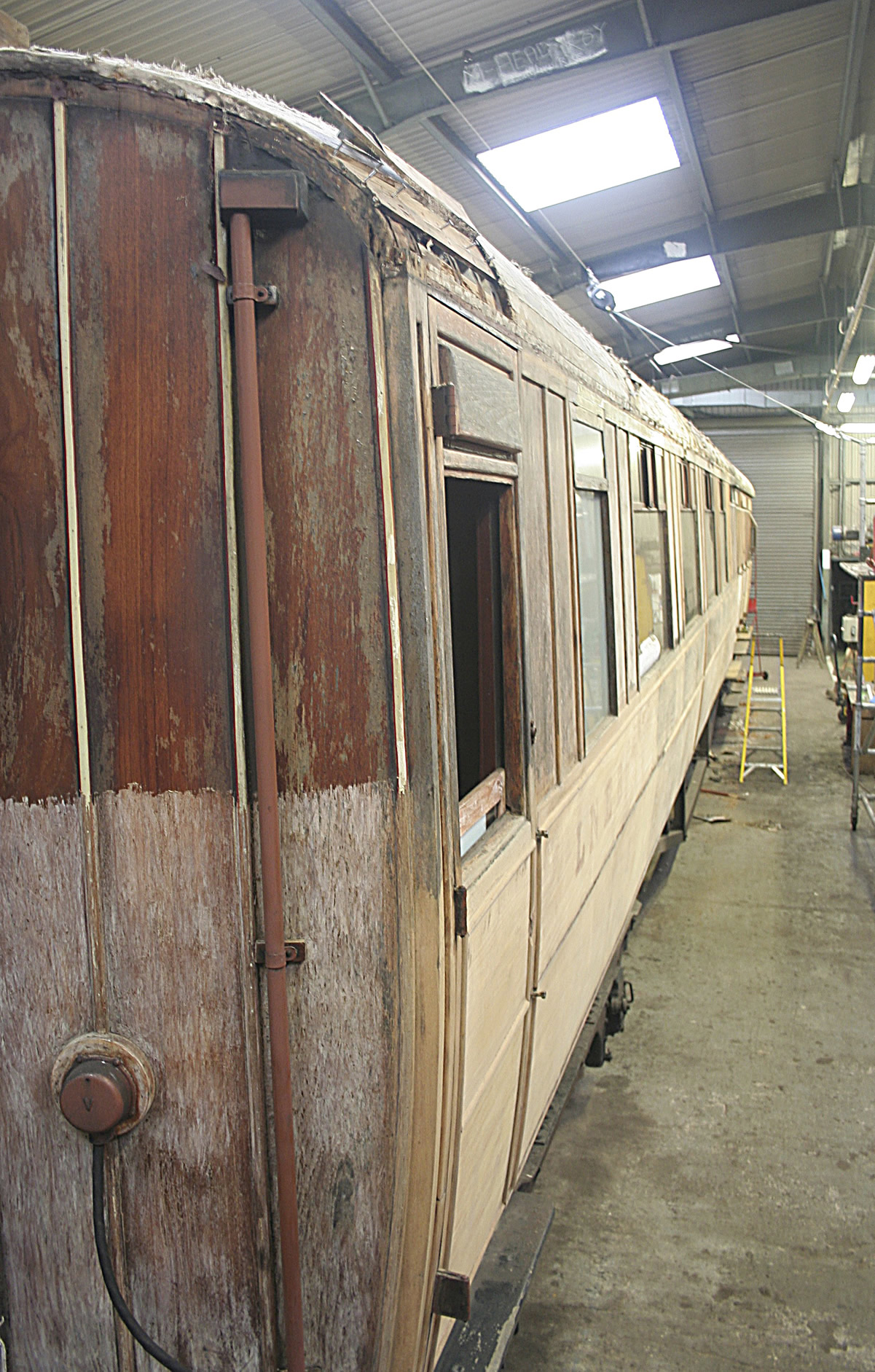
Meanwhile, in the main C&W shed, the soul-destroying job of stripping BTO No. 43567’s varnish off down to bare wood has been underway.
In addition, the roof canvas has also been stripped. In this picture, some of the yet to be stripped residual varnish on the carriage end can be seen – in dreadful condition. It is anticipated that the entire job will take three months.
Photo. Murray Brown.
Gresley Corridor Brake Third No. 3669 goes under cover – March 2019
The owners of BTK No. 3669 breathed a sigh of relief on February 26 when their pride and joy, No. 3669, was placed inside the new shed at Kirkby Stephen, Stainmore Railway, where it joins Luggage Composite No. 1111, also recently departed from the NYMR.
The owners were exercising an option in the agreement whereby if covered accommodation could not be provided by the NYMR within a stated timescale, then the carriage could be moved elsewhere to fulfil that ambition.
An immediate undertaking at Kirkby Stephen will be to give No. 3669 a coat of varnish.
It has been publicly stated that once shed space can be found, then No. 3669 is likely to return to the NYMR. Provision of a carriage ‘stable’ is one of the four main planks in the submission by the NYMR for Heritage Lottery Funding, titled ‘Yorkshire’s Magnificent Journey’. The Railway is expecting an announcement from HLF in late March or April.
No. 3669’s place in the LNER set will be taken by Gresley Brake Third Open No. 43567 which has entered the C&W workshop at Pickering to be revarnished. Unfortunately, rather than just a clean and a rub-down, the state of the bodysides will necessitate a complete strip down to bare wood – see below.
Water damage found
We now have three LNER carriages which have been found to have suffered from serious damage from water ingress.
The first to be found was Restaurant Buffet No. 641, undergoing extensive repair and renovation at Wirksworth, Ecclesbourne Valley Railway. Water had got in, not only from a non-watertight roof, but also down windows and gathered behind the vinyl alongside the plywood panels. All of this has had to be stripped out.
Now we have found TTO No. 23956 and BTO No. 43567 have also been the victims to the No. 1 enemy of carriage restorers – H2O.
The BTO No. 43567 has now entered the C&W shed for long overdue varnishing. As with TTO No. 23956, the roof has started to leak, so it is no surprise that it is suffering the same problems. We have not yet been able to access the roof but it is likely a rotted canvas is the culprit, necessitating a full replacement of the canvas and roof mouldings etc. Inside, the east side is showing early signs of deterioration of the ply side cladding but no major rot yet. The west side has major rot and will need complete replacement. Water has leaked through the roof boards into the van area and there may be rotted roof boards. The teak outer panels are badly water marked and we doubt the stains will sand out but they look to have remained attached to the pillars (unlike in 23956) so we are hoping that the glue blocks are OK. Our Thursday team is stripping out tables, seats and cladding to allow things to dry out, further news will follow.
All this highlights, yet again we are at the mercy of the elements, standing outside in all seasons. Rigorous attention to the varnishing and roof painting periodicities is another key factor and we are optimistic that the NYMR management will be able to provide the resources.
The CCT – looking good
As each week progresses, our faithful stores vehicle, 1950-built Covered Carriage Truck (CCT) No. E1308, looks better. The first coat of LNER brown has appeared on the first of the newly re-panelled sections on the west side of the vehicle (car park side). This side has the worst woodwork defects to repair. The Association is pleased to recognise and thank members of the Pickering Wagon Group for helping on this project. In effect, the CCT has taken the PWG’s space in the shed, so the sooner it can be moved outside – when a new roof covering has been fitted – then the Wagon Group can resume normal duties.
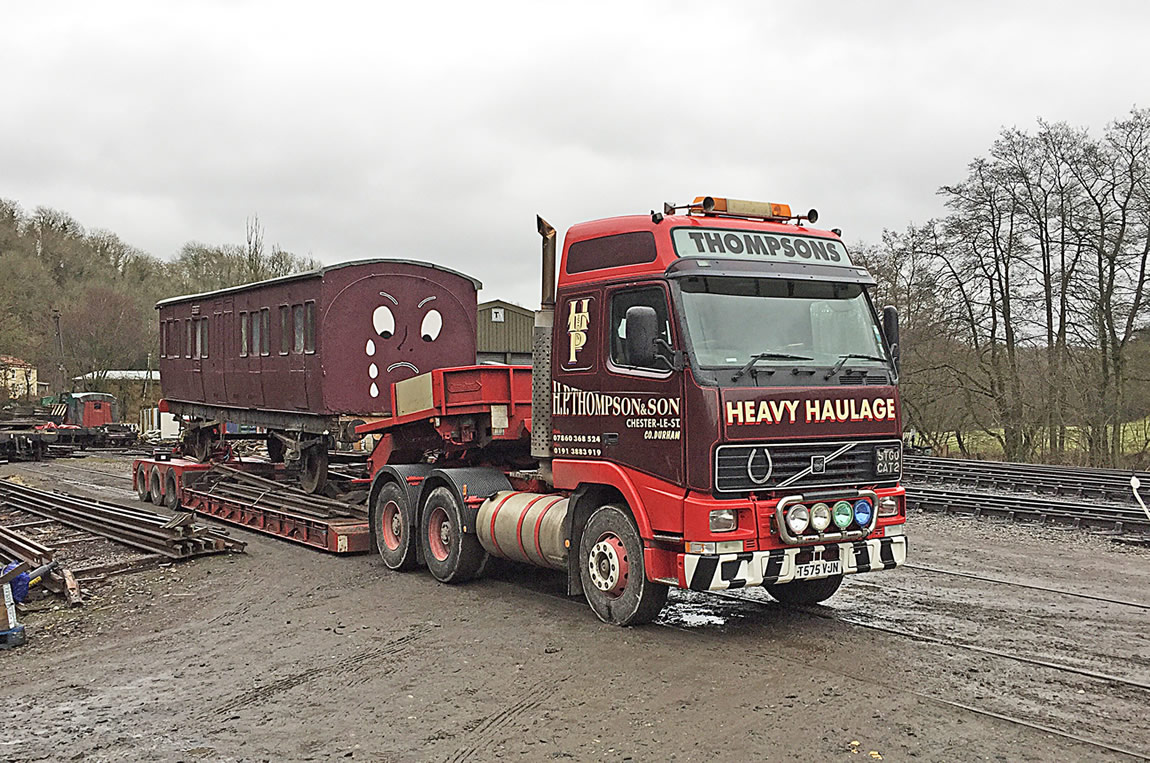
After enjoying 37 years on the NYMR – all of which was spent at Levisham, Luggage Composite No. 1111 is about to leave New Bridge yard on February 5 for its new home at Kirkby Stephen, Stainmore Railway, where its volunteers will endeavour to return it to original condition. The LNERCA took the view that this was the best course of action for its future as No. 1111 would be way down the queue for rebuild by LNERCA volunteers. Photo: Dave Cullingworth.
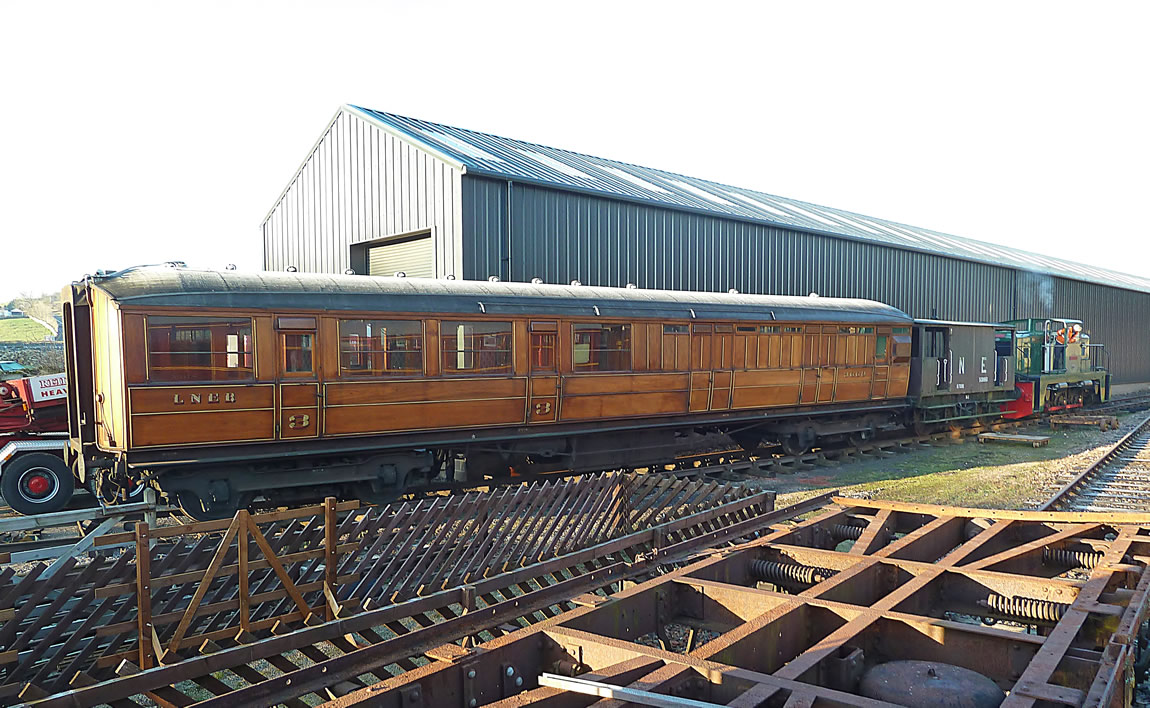
Dateline: February 26. Gresley BTK No. 3669 is lowered down the ramp at Kirkby Stephen on February 26. The shed in the background will be its new home. Should the NYMR be successful in its bid for Heritage Lottery Funding and a carriage stabling shed be provided, then No. 3669 will once again be gracing the metals of the Moors Railway. Photo: Rob Murray.
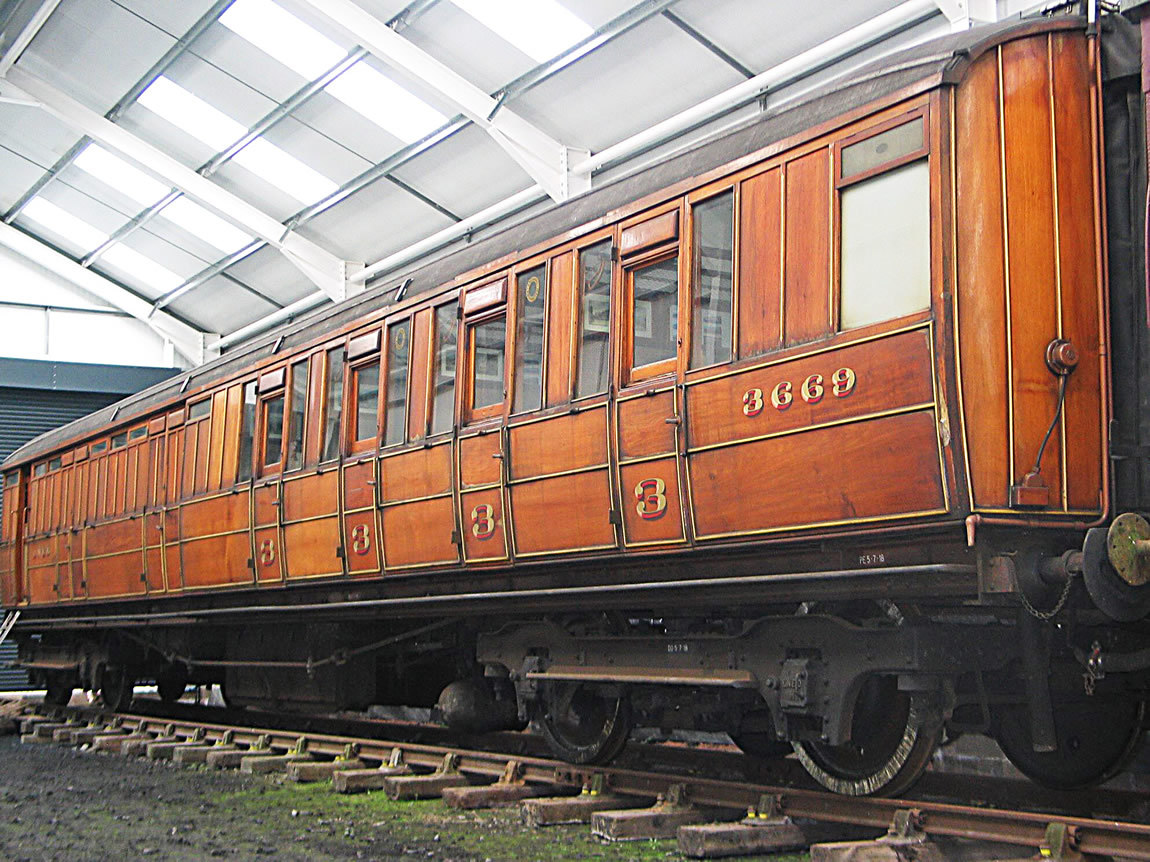
A dream of all carriage restorers – to see their beautiful vehicles under cover. No. 3669 resides in its new home in the new shed at Kirkby Stephen – and not a drop of rain to be seen! Photo: David Rayner.
One side finished on the CCT – Feb 2019
The east side (rail side on the Atkins shed) of Covered Carriage Truck (CCT) No. 1308 is now finished, apart from the numbering and lettering. The complete side has been renewed – vertical planking and the three doors – all decked out in LNER Brown.
However, walk round to the east side and what a stark difference. Apart from the first section of planking now in place, the entire bodyside is devoid of its old derelict doors and planking. The remaining crumbling and splintered planking was removed on Saturday February 9, exposing the framing.
There are numerous parts which are loose or will require renewing before the planking can be fitted.
One door corner pillar was completely rotten and only the top three feet remains. This will necessitate a new pillar machining and fitting. Meanwhile, an Acro prop has been fitted to help support the roof.
The three doors for the east side (car park side) of the CCT have already been made. All metalwork is removed from the derelict doors and fully refurbished. Once painted in top coat LNER Brown, they are all bolted to the new doors.
It is planned to fit these three doors using the C&W’s huge fork lift truck once the CCT can be shunted outside.
This will not happen until the roof is finished. To effect this, a new roofing material is to be trialled. The C&W Manager, Kieran Murray, has kindly allowed the CCT to be in the Atkins shed for up to three months – perfect and somewhat necessary when applying new roofing materials. The LNERCA is also grateful to the Pickering Wagon Group for taking their usual space.
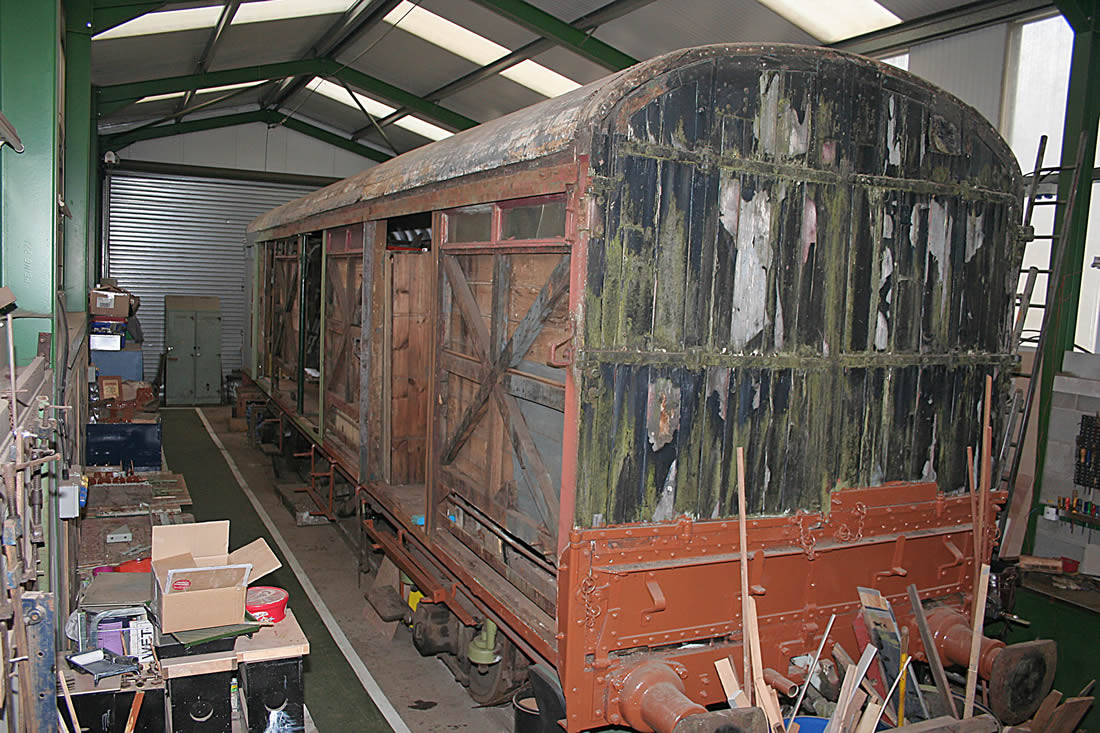
All work is now concentrated on the east side of the CCT, the side adjacent to the public car park. With all the exterior bodyside panelling removed, an assessment can be made of the framing onto which the vertical boards are screwed.
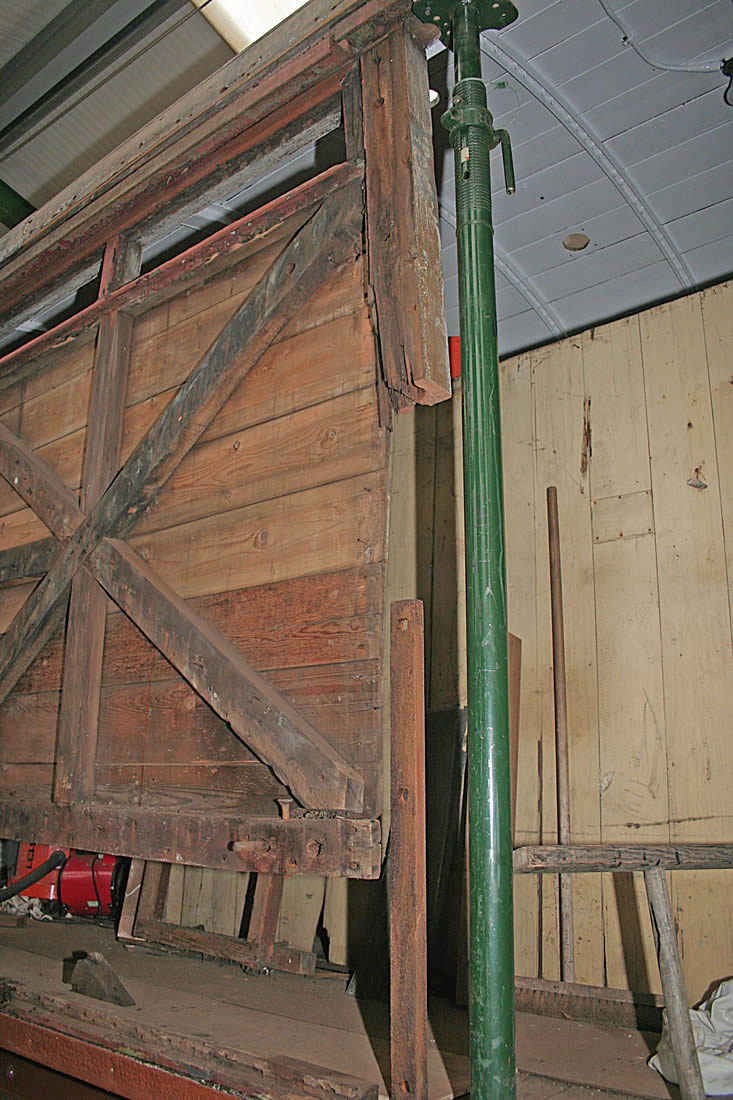
This is the worst section of the bodyside panelling. The corner pillar has all but disintegrated, leaving just about three-feet hanging down. Either a new piece of Oak will be machined and fitted or extensive splicing will be put in hand.
The green Acro prop has been used to ensure the roof does not sag whilst this work is undertaken. Oak was used in quantities after the second world war (No. 1308 was built in 1950 to the earlier LNER design) due to difficulties in obtaining teak from the east.
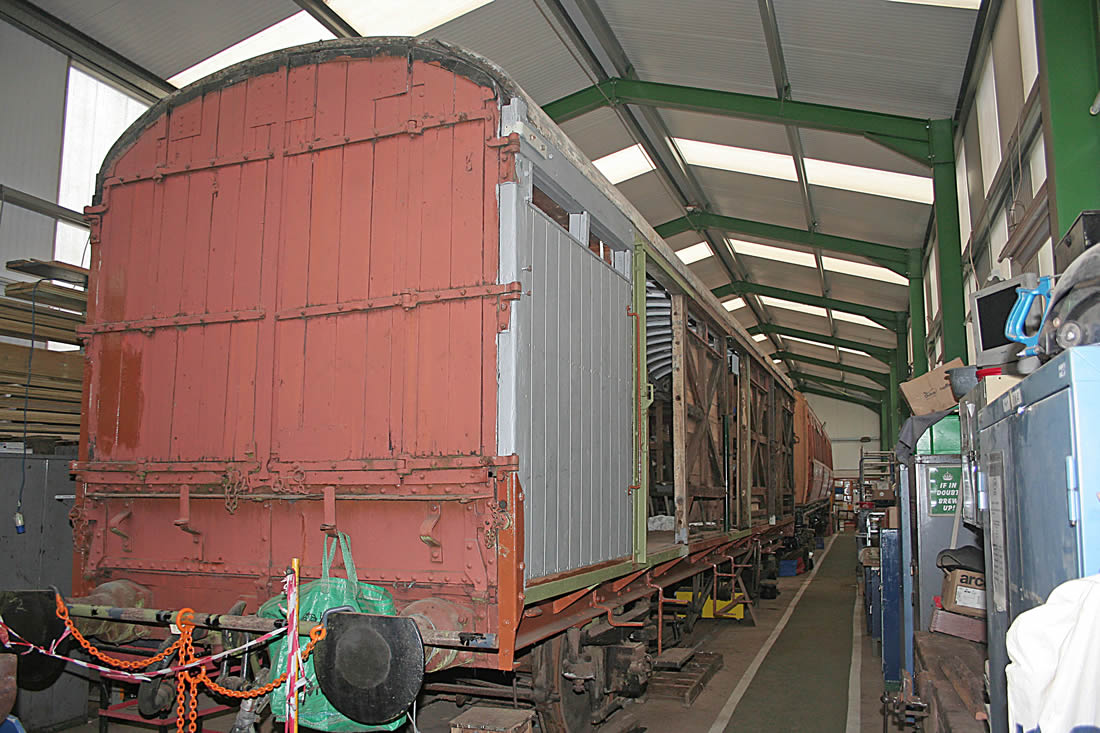
The first section of new tongue and groove boarding has been screwed into place at the northern end of No. 1308. Not all the metalwork fittings have been bolted on. This section awaits undercoat, followed by top coat of LNER Brown.
Under cover
NER Luggage Composite No. 1111 left the NYMR on Friday February 7 and, after spending the night at Scotch Corner, arrived at Kirkby Stephen on the Saturday and immediately was put into the new shed. This was the first time this carriage has been under cover at least since 1924 when it was withdrawn from service and passed into Departmental service at Bishop Auckland, i.e. over 95 years! Indeed, it may well have not seen a shed for over a century.
BTK No. 3669 is set to follow the same route later in February.
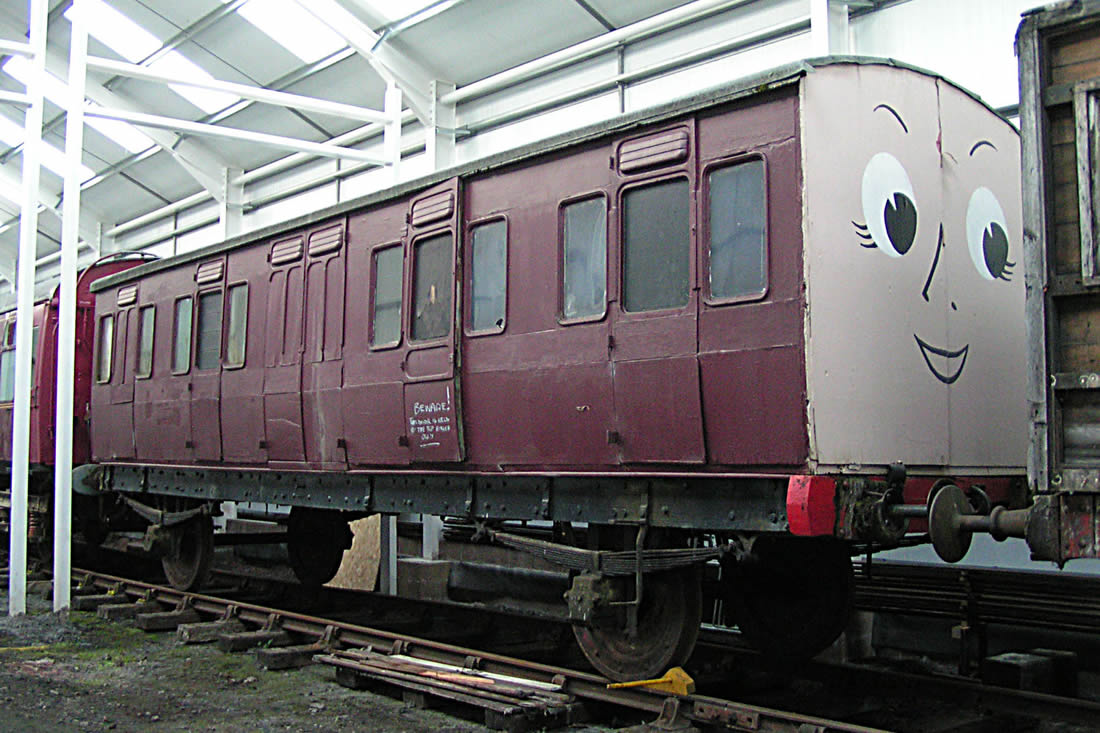
In a shed at last for the first time in nearly a century. Luggage Composite carriage No. 1111 resides in the new building at Kirkby Stephen where restoration will start. The middle wheelset will be put back in due course.
Ah, yes, the face. This was applied by the Levisham station volunteers in order to appeal to children. Let us hope the smile will soon be wiped off it – not befitting for North Eastern Railway heritage!
Photograph by Mike Thompson.
Archivist John Sutcliffe
The committee and volunteers are mourning the passing of John Sutcliffe, the LNERCA’s Archivist, who passed away a week before Christmas. He was 75 and had been in poor health. John joined the LNERCA committee in 2008 as an ordinary member and a year later took on the mantle of Archivist. He set to and soon began to assemble an impressive library of documents and photographs of all things LNER rolling stock.
His love of railways manifested itself particularly in historical matters and live steam. He was a member of the York Model Engineering Society, based at Dringhouses and was a friend of Bob Polley who had a layout at Barton, just off the A64 to Malton. Because of his friendship with Bob, John was instrumental in arranging for the LNERCA’s NER First Open No. 2118 to be stored on Bob’s land and John became in effect its custodian. He was looking after several of the components from this unique carriage.
Another of John’s favourite vehicles was the LNERCA’s Fish Van and he was so looking forward to seeing it take shape this year.
ECJS No. 189 was also on his ‘top list’ and he gained much pleasure from seeing it progress.
One of the quieter members of the committee – that’s no bad thing – but nevertheless, John had a great sense of humour and had the LNERCA’s interest very much at heart.
He leaves behind his wife Margaret to whom he was devoted and three step children who he called his own. A really nice man and the committee extends its condolences to his family.

